| Author |
Message |
    
Ld
Username: Ld
Registered: 01-2007
| | Posted on Saturday, August 27, 2016 - 05:22 pm: | |
两位正社旅行發燒友—冒懷慶和林鼎彜稻城遊記四日
林鼎彜
今年四月下旬至五月初期間,两位正社旅行發燒友冒懷慶和林鼎彜,頓感旅游發燒温度不够,决定選擇甚至連中國旅游狂熱愛好者都認為是評判旅游發燒度數高低指標之一的——稻城亞丁——作為他們升温的目的地。有人說到此地旅遊的人是
因為在中國的旅遊景點中再找不到可去的地方才選擇亞丁稻城。只有瘋子才會這樣虐待自已。可能都是,但還請聽聽去過的人他們自已怎樣說吧!
稻城亚丁概况《節錄自人民网——稻城亞丁旋游全攻略》
稻城亚丁这个地处川、滇、藏三省区结合部,横断山脉中南部高山深谷的不知名的地方,在短短的两三年间,便成为众多旅游发烧友心目中的圣地净土,其吸引力的指数不断攀升。异常艰辛的旅途也未能阻挡他们前行的步伐,到稻城亚丁去探奇揽胜成为一种时尚,成为一个评判旅游者发烧度数高低的重要指标。
稻城县位于四川西南边缘,甘孜藏族自治州南部,地处青藏高原东南部,横断山脉中南部的高山深谷中,距成都791公里。稻城东南与凉山州木里县接壤,西与乡城县、云南省中甸县毗邻、北连理塘县。南北长174公里,东西宽63公里,面积7324平方公里。稻城全县人口近三万,其中藏族占96%以上,此外还有汉、纳西、回、彝、羌等民族。
稻城,古名“稻坝”,藏语意为山谷沟口开阔之地。清光绪三十三年(公元1907年),曾在境内试种水稻,预祝其成功故取名稻成,后置“稻成县”,1939年,当时的西康省成立时,改名“稻城县”。《節錄自人民网—稻城亞丁旋游全攻略》
进入稻城交通提示。《節錄自人民网—稻城亞丁旋游全攻略》
成都至雅安为高速公路,雅安至理塘县为318国道的柏油路,理塘至稻城至日瓦至亚丁为碎石路,2001年9月25日稻城至日瓦至亚丁公路改造完成,旅游车可直抵亚丁,此路线全程899公里。从亚丁村至冲古寺再到洛绒牛场需徒步或骑马,因山道崎岖,骑马时需注意安全。
成都—413km—新都桥—378km—稻城—75km—日瓦—33km—亚丁—5km—冲古寺—10km—洛绒牛场《節錄自人民网—稻城亞丁旋游全攻
略》
进稻城县主要有两种行程:一是从云南中甸经四川乡城县再到稻城县,二是从成都往西经康定、理塘(川藏南线)再折往南到稻城县。中甸与成都之所以是出发点是因为这两地有靠近稻城的最近机场,从而方便计算行程。《節錄自人民网—稻城亞丁旋游全攻略》
我們這次的行程簡記大概如下:
4/28 早上八時在香港機場會見由温哥華來港轉機去南韓的正社氣袋—鄭榮坤。
十時左右,离港飛往四川成都雙流機場,在機場出口處與冒懷慶會合,晚上與冒懷慶姊夫及家人吃重慶火鍋。
4/29 成都—康定﹙舊稱打箭爐﹚ (成雅公路,一等。雅安—康定,中等。全程約七小時,包括停車雅安品嚐雅鱼,蒙山名茶。拍攝紅軍長征革命勝地瀘定的大渡橋橫鉄索寒景色。二郎山隧道前高唱二呀那二郎山。大家興奮得有點“老來紅”)。五時左右到達姑咱康定師專。我們西進第一站。
4/30 康定—稻城杜鵑谷聖女温泉招待所。路况:中等。
在康定購買預防高山症藥品紅景天,肌苷口服液,由于五月一日勞動節,全中國放長假,旅遊旺季,药品需求緊張,以上藥物極不容易找,更難找到正貨,因此耽擱了起程時間。在依思和噶瑪﹙藏族朋友及同遊者﹚為我們購買藥品其間。在情歌大飯店前巧遇康定電視臺記者,大概老冒和我的外貌不像康巴漢子。引起行人注意,記者堅持要訪問我倆。康定電視臺訪問我等時冒公子康定街頭高歌世間溜溜的女子,任我溜溜的愛喲。幾乎引起非法群眾集會
離開康定後,大部分時間在3400m—4800m( 即11000ft—16000ft)的高山行駛。經過拆多山口時 4279m即14039ft 山上還在下雪。在高爾寺山口 4412m 即14475ft冒懷慶開始有高原反應。新都橋用午膳﹙新都橋位于南北走向的317與東西走向的318兩條國道交界,是勞改營,穿囚衣犯人到處可見,由于小橋流水遍佈附近,秋深時草原色紅似火,故又被稱之為攝影家天堂﹚吃過新都橋雅江飯店的“美人髮野菌”後,林鼎肚裏開始“閙革命”。今日路程很長,全程約十五小時。經過的高山也特多,除了以上提及的,還有剪子彎山口4659m 即15286ft。卡子拉山口 4718 即15480ft。便到達世界高城理塘,雖然這是一座很具規模古城,六世達賴在他著名情詩中也提過 “天空潔白仙鹤,请把雙翅借我,不到遠處去飛,只到理塘就回!”但很少旅客有胆在此住宿。太高了。誰都害怕睡至半夜停止了呼吸的事故。離開這座讓六世留情的古城後,我們的坐車便向川南進發。再經扎嘎神山 4453m 和幾座無名但高達4800m的山峰後,便到達稻城。可惜來到這座令旅行攝影發燒友聽了便肅然起敬的縣城時,已是近晚上十時了。除了看到路傍两排還未長出新葉的白楊樹和幾家燈火外。整座縣城都好似在茫茫黑夜中尋它好夢去了。過了稻城,再南行四十分鐘,便到達杜鵑谷聖女温泉招待所。我們川西旅遊第二站。雖然我們每一房間都有私人温泉浴室,但經過十多小時顛簸旅程,和深夜刺骨寒風,我猜誰都像我一樣,放下行裏後,連衣服也不換便鑽進棉被睡覺了。
5/01 稻城杜鵑谷聖女泉—日瓦﹙亞丁自然保區入口﹚—亞丁村—沖古寺—洛絨牛場。(全程約九小時。路况:極顛簸。頭撞車頂是常常發生的事。不是越野四輪駕駛車輛大概不可能行駛在此等路面。全程約在4300m 即14000ft 左右的山間行駛。到了日瓦村,也即是最主要景點入口處,林鼎和懷慶是這次進景區年齡最高的两位,林鼎獲得免費入場,懷慶還差三歲才具備免收入場券的資格。進入保護區後,要乘坐保護區內巴士,這是一個半小時下身極難受的路程,風景絕美,可惜道路崎嶇而且用泥石鋪成。塵土飛揚,尤以在两車迎面相遇時,一切美景都會消失或蒙塵。到達巴士終站亞丁村後,便要步行或騎馬才能到達冲古寺和絡絨牛場——觀賞三座神山最佳地點。在高原缺氧的情况下,步行是極其艱苦的,所以我們放棄步行方式進入牛場。由亞丁村騎馬到沖古寺約個半小時,在沖古寺用午餐後,再騎馬二個半小時,才到達絡絨牛場。這四小時馬上感受是永世難忘的。我承認:第一怕得要死,第二從腰到脚僵得要死,第三樣子難看得要死。第四被騎的馬累得要死。冒懷慶自以為馬術超群,想把林鼎難看的馬上“雄姿”拍下來,刊登在正社網站,差一點弄得人仰馬翻,若不是三名馬伕及時搶救,刊登在網站上難看的照片恐怕是冒公子了。
大約下午五時左右,我們終于到達洛絨牛場——三怙主雪山的中心地區。這個在
佛教24座聖山中排名第十一位,屬眾生供事朝神積德聖地。美國探險家約瑟夫·
洛克 Joseph Rock 也在1928年的《國家地理》雜誌推崇它是“在整個世界上還有什麽地方能有這樣的景色,等待着攝影者和探險者的”。稻城亞丁!多少旅行攝影發燒友夢想的仙境,我三年來的心願。終於能置身其中了,現在我可以自豪地說:我曾经到過絡絨牛場了。這句極平凡的話,和元稹的“曾經蒼海難為水,除却巫山不是雲”是同等份量的,它代表着太多的含義了。站在三座聖山中心的絡絨牛場,對着像李白所說“山從人面起,雲傍馬頭生”的群山中。我明白羅曼羅蘭在彌盖朗琪羅傳為什麽這樣寫:“我不說普通的人類都能在高峰上生存,但一年一度他們應上去頂禮。在那裏,他們可以變換一下肺中底呼吸,與脈管中的血流。在那裏,他們將感到更迫近永恆。……人們在那裏呼吸時,比別處更自由更有力。純潔的大氣可以洗滌心靈底穢濁;而當云翳破散的時候,他威臨着人類了” 。記得幾年前讀到Anatoli Boukreev’s 《Above the Clouds》中以下一段時。
“Mountains are not stadiums where I satisfy my ambitions to achieve. They are cathedrals, grand and pure, the house of my religion. I approach them as any human goes to worship. On their altars I strive to perfect myself physically and spiritually. In their presence I attempt to understand my life, to exorcise vanity, greed, and fear. From the vantage of their lofty summits, I view my past, dream of the future, and with unusual acuteness I experience the present moment. That struggle renews my strength and clears my vision. In the mountains I celebrate creation, for on each journey I am reborn.”
我曾對自己說,在有生之年,一定要到高山去。起碼去一次,體驗一下高峰帶來的感受。現在實現了,在到處被人““尊””稱為老先生之年,實現了上高山去一次的心願。
我們感到興奮,體力上也感到非常疲勞。老冒、依思、噶瑪和我,還是靜靜地慶祝着幾經辛苦而來的體驗。在這高原缺氧的群山中,我們不能喝酒慶祝也無杯可舉,更不能有太大的跳躍動作和歡呼。傳說在聖山前不得呼叫,怕觸怒山神。但從大家會心的微笑中,我們明白各人心中是共同快樂着同樣的勝利。
老冒被高原反應搞到只好回帳篷坑上睡着吸氧。營地大夫來檢查他,要他好好休息。這是我見過老冒最聽話的一次。我雖沒有高山反應,但幾天來由于食了不潔食物而肚痛,也搞到混身無力。高原傍晚的寒風,把所有人都驅趕回帳篷內去,只剩下我與空谷中的馬鈴聲,憑吊着今日最後一道餘暉在聖山之顛消失。一種由戰勝體力而來的寧靜與平和,支配着我的全部。我完全沉醉在這威嚴穆靜的群山與空谷之中,直到拿着三脚架的手心冷得作痛,我才發覺,我連想也沒有想過把眼前勝景拍攝下來,留為紀念。我並沒有後悔,就算拍了,最多也只能將它輪廓的美留在定格裏,但它的神髓和它那種威臨人間的穆靜與莊嚴,任何鏡頭大概都無濟于事。只有長時間浸淫在其中,讓它熏陶自己的身心,也許略能領悟其中一二。
暫不多寫了,免得悶到大家發慌。日後有時間時,再寫些這次旅程的趣聞和有關老冒的小故事。
以下是與行程有關参攷資料,若有興趣請繼續讀下去
雅安三绝
“雅雨”、“雅鱼”、“雅女”并称“雅安三雅”。
久仰其名不算真,真正见识了,你就会承认:沐雅雨,产雅鱼,养雅女,周公山的三雅最地道。
雅安的雨当然是“雅雨”,不过似乎只有这里的雨,才堪称“雅”。如云似雾,恍若轻纱,似有若无,温润的空气搀和着大量的负氧离子,在这样的雨中漫步,赏雨,或者细心谛听雨脚落在周公山麓,落在花枝,落在周公河水里的绵密场,再怎么样焦躁的心绪也变得柔和起来。
周公河,其水清澈见底,环周公山缠缠绵绵几百里。河里石缝、岩壁之下,藏匿着一个传奇——这就是“三雅”之一,雅鱼。
相传,雅鱼头骨内暗藏一柄“宝剑”,为战国时苏秦所持,苏秦离间诸国后,车裂身亡,其佩剑滑落江中为雅鱼所藏,以至于成为日后鉴赏雅鱼的“防伪标识”:有剑则真,无剑则假。雅鱼藏匿水中,以鲜活之物为食,其肉细嫩鲜美无比。用雅安荥经所产的沙锅,盛周公河中之水烹制的“沙锅雅鱼”,其味让人没齿难忘。
一方水土养一方人,雅女,大概是因为雅雨的滋润,雅鱼的营养,所以雅安的女子,一个个或如出浴的荷花,或如带露的玫瑰,不仅秀丽清纯,而且温雅良善。雅安因雅鱼而丰美,因雅雨而多姿,因雅女而妩媚。三雅像一块巨大的磁石,吸引着四面八方的人们不断地涌向雅安。、
“扬子江中水,蒙顶山上茶”
在民间流传甚广。深谙音乐和茶道的唐代大诗人白居易把弹渌水、品蒙顶茶作为人
生一大快事,留下了“琴里知闻惟渌水,茶中故旧是蒙山”的评析。
毛澤東詩詞 七律 长征 1935.10
红军不怕远征难,万水千山只等闲。
五岭逶迤腾细浪,乌蒙磅礴走泥丸。
金沙水拍云崖暖,大渡桥横铁索寒。
更喜?山千里雪,三军过后尽开颜。
【注释】
长征:一九三四年十月中央红军从江西、福建出发,于一九三五年十月到达陕北
,行程二万五千余里。
五岭:大庾岭,骑田岭,都庞岭,萌渚岭,越城岭,或称南岭,横亘在江西、湖
南、两广之间。
逶迤(wei1 yi2):弯弯曲曲延续不绝的样子。
乌蒙:云贵间金沙江南岸的山脉。
走泥丸:《汉书·蒯通转》,“阪上走丸”,从斜坡滚下泥丸,形容跳动之快。
铁索:大渡河上泸定桥,它是用十三根铁索组成的桥。
?山:在四川和甘肃边界,海拔四千米左右。一九三五年九月红军长征经此。
康定是一座历史悠久的高原古城。古城三山环抱,二水夹流,折多河贯穿城中,富有民族风格的各式建筑错落有致地散布于河两岸。悠悠民歌声,翩翩民族舞,极富高原民族风情特色。康定,旧称打箭炉,位于川西贡嘎山北端跑马山麓。是甘孜藏族自治州首府。
女余純順?——稻城亞丁遊記第五日 林鼎彝寫
『冒先生,你還要不要與我到五色海去呀?』小韓以目前國內大多數少女說話時又嬌又嗲的語氣向還躺在坑上的老冒說。
各位請千萬別誤會,這絕對不是我們以前國文課讀過的『低聲問:“向誰行宿?…不如休去,』。那樣温柔,情意綿綿的李師師與宋徽宗之對話。雖然小韓昨夜的床位確是在老冒旁邊,這是洛絨牛場帳篷住宿管理委員會的規則,床位的安排是按照入營先後次序編排的,絕對不以人們的意志而轉移。倘若在你入營之前或之後是一位發麻瘋的你也得睡在他/她旁邊。我們也許羨慕老冒有如此〝福氣〞。不過老冒却不以為然。他第一次起來到帳篷外拍攝那張傑作《高原旭日紅勝火》時,他向我可像哭訴一樣說:“真惨呀!簡直無法入睡,床位窄到連屈膝都不能,我的手幾次碰到小韓的頭髮,連轉身都不敢,只好僵直地躺着待天明。
成为近代的柳下惠” ---岁月不饶人﹙紅色句子是老冒讀後補充的﹚
還有當我們好好了解一下五色海、牛奶海這兩個高山湖泊的高度,和它們與牛場的距離,就明白這句語氣嬌柔的問話,後面蘊藏着的含意。從洛絨牛場4200m,步行至海拔4400+m的牛奶海、再攀登到海拔4800+m的五色海,然后依原路返回牛場,全程需時五至六小時。在這缺氧的高海拔的山中,連騎馬都不擔保安全的傍山險路上,歷程艱巨而且極度危險,有些地方不但寸步難移,一不小心,連生命都難保的時候,你就清楚知道,不管問得多麼嬌嗲,但跟着而來的則是比鉄還要無情、不能存有任何幻想的嚴肅問題。譬如:你對自已的决心和體力有信心嗎?你有沒有考慮過高山反應這個問題呢?對沒有受過專業登山訓練的我們,有什麽意外時你能招顧自己嗎?……等等。
老冒对这温柔語氣的回应倒是意外的:“对不起,我头疼………”一般西方语意的回答﹙紅色句子是老冒讀上段後,補充的﹚
小韓的語氣雖然柔和温馨,人也長得嬌小細緻。但當你聽過她輕描淡寫地講述前年孤身獨行去海拔4586m—5630m的岡仁波齊神山﹙也稱阿里神山﹚轉山的故事後,又跑到四条大河源頭﹙獅泉河、馬泉河、象泉河和孔雀河﹚附返的瑪旁雍錯——世界上海拔最高4458m的淡水湖,而沒有半點炫耀自已過人的膽色和體力時,你所見到的就不單是她外表的嬌柔之美了,而是一種經歷無數磨練而來的超脫,一種混合着深藏不露的無比勇氣、和戰無不勝的堅強意志的精神之美。這種現代很多女性缺少的從內面發放出來的美。使小韓顯得非常與眾不同,一方面她像空谷幽蘭,另一方面她又像暴風雨中的松柏。
記得第一次她引起我的注意,是在前往冲古寺的路上,差不多所有進入牛場的遊客都是騎馬的,而她却是背着背包隻身徒步在崎嶇的傍山路上。
第二次見到她是在冲古寺至牛場這段路的中途。我是怕得要死的坐在向牛場進發之馬上,她却悠閑孤獨地坐在溪澗旁的石上,在群山環繞的峽谷裏休息與沉思。我很想知道自然在她內心世界裏起了怎樣的影响,使她可以如此忘我似的全部投入,這種悠悠自得的入靜之境界,絕非匆匆趕路者可能到達的,只有哲人與靜者在有意無意中才能領會。
第三次見她,是她被安排到我們住宿的五號帳篷。她的床位是最近帳篷出入口處,不知她是為了安全,抑或因外面刺骨寒風而不想在高原患上可能致命的感冒,她總是把帳篷門小心扣上。因此每次要到外面拍照、吃晚飯,上廁所、或不想悶在帳篷內。就得麻煩她或者要說聲對不起。麻煩次數多了,對不起說够了,自然就变得熟落。壓抑了半天的問題,也就很容易找到發問的缺口。首先向她表達我們的敬意,她這份無比勇氣從何而來?獨行俠似在中國偏遠地方旅行的經歷。繼而談到《孤身徒步走西藏》的作者余純順。她否認自己是女余純順,也絕對沒有余純順那種與天斗、與自已斗的意志。更沒有他那種百分之百步行的頑強精神。但她為這位現代徐霞客正當盛年的時候,在羅布泊遇難而感到惋惜。她說:“以前在讀他的作品時,常常被他的經歷感動到難以平靜。我敬仰他,一位有血有肉的、與平常人如此接近的英雄式的真人!他可像是自已的家人,又是一種不讓人們往下沉的力量”。
在這個物質重於一切的時代。財富地位代表着大部份人的價值觀念的社會。不甘平庸凡俗的人們,多麽需要一位這樣的英雄,一個敢于挑戰世俗觀念、挑戰自我、挑戰自然的踐行者,來給我們生存勇氣和力量。可惜,他們都匆匆流逝!
她站在老冒床邊,等待着老冒完成他的答案。然後向大家說聲珍重,便奔向她自已的前方去了。
光陰!你慢飛馳!宜人的美景良辰,
且莫匆匆流逝!
讓我們細細品嘗這稍縱即逝的温存,
此生的賞心樂事,
錄自法國詩人拉馬丁名詩《湖》。作為這次舊雨新知稻城亞丁旅遊美好回憶紀念。
老冒头脑简单的回答换出来的却是老林很难言喻,那丰富感情的表达!想当年。岁月如飞啊!这次登山西域的经验使老冒更了解生命的短暂与死亡的可待﹙紅色句子是老冒讀上段後,補充的﹚
以下是名曲【友誼萬嵗】歌詞,為老冒後來補上的。
“Should auld acquaintance be forgot
And never brought to mind?
Should auld acquaintance be forgot,
And auld lang syne?
For auld lang syne, my jo,
For auld lang syne,
We’ll tak a cup o’ kindness yet
For auld lang syne.”
Robert Burns
|
    
Ld
Username: Ld
Registered: 01-2007
| | Posted on Tuesday, August 21, 2012 - 03:03 pm: | |
Click to View a Photo Video of Japan Trip 2012 (HD 1080p)}
http://www.youtube.com/watch?v=pDOjaETP3uk
|
    
Ld
Username: Ld
Registered: 01-2007
| | Posted on Monday, August 20, 2012 - 09:51 pm: | |
http://tech.163.com/digi/12/0904/15/8AIM1KPB001624J3.html
影像源动力 数码相机CMOS来源汇总(上)
2012-09-04 15:07:07 来源: 网易数码
『写在前面』
众所周知,感光元件(图像传感器)是影响一款数码相机画质表现的重要因素之一,它在很大程度上确立了一款数码相机的画质基准。在接下来的内容中,小编会和大家分享主流感光元件的规格资料,希望能对大家的选购带来一些帮助。
『35mm画幅』
自 2001年Contax N Digital发布以来,35mm画幅(36mm×24mm)数码相机经历了10余年的发展,逐步进入到普及阶段。虽然距离真正意义上的普及还有些时日, 但市场上能让普通摄影爱好者买得起的产品确实是越来越多。目前,在售35mm画幅数码相机共有12款。除徕卡M9(网购最低价 50550.0元)采用CCD感光元件外,其它所有产品均采用CMOS感光元件。
1.佳能EOS-1D X、EOS-1D C
佳能EOS-EOS-1D X (参数 图片 文章)采用了自主开发、生产的约1810万有效像素35mm画幅CMOS。像素间距达到了6.95×6.95微米,比EOS-1D Mark IV(参数 图片 文章)所采用的APS-H感光元件大约48.6%。这款CMOS具备16个数据通道,可将捕捉到的画面信息迅速输出到A/D转换电路及图像处理器,为实现高速连拍奠定了硬件技术。此外,佳能还通过调整画面边缘微透镜的入射角度,缓解了周边光亮下降等问题。
影像源动力 数码相机CMOS来源汇总(上)
佳能EOS-1D X所采用的约1810万像素35mm画幅CMOS。
从目前掌握的资料看,EOS-1D C采用了与EOS-1D X(网购最低价 46666.0元)完全相同的感光元件。只是通过软硬件优化,实现了4K级(4096×2160 24p)高清视频拍摄以及对应Super35画幅(约24.6mm×13.8mm)全高清视频拍摄等规格,从而满足影视制作领域的使用需求。
2.佳能5D Mark III
佳能5D Mark III(网购最低价 19879.0元)采用了自主开发、生产的约2230万有效像素35mm画幅CMOS。该CMOS实现了整个ISO范围内的大幅度降噪,同时实现高像素和低噪点化。与EOS-1D X所采用的CMOS相比,该CMOS的数据通道减至8个。
影像源动力 数码相机CMOS来源汇总(上)
佳能5D Mark III所采用的约2230万像素35mm画幅CMOS。
从目前得到的资料看,佳能应该还有一款定位更低的35mm数码单反相机(6D?)。不出意外,这款产品会采用与5D Mark III相同的感光元件。
3.尼康D4
尼康D4(网购最低价 37490.0元)采用了型号为NC81366W的约1625万有效像素35mm画幅CMOS。它的有效像素比D3/D3S (参数 图片 文章)增加了约33%,并且传输速度超过了此前任何一款尼康数码相机。值得一提的是,该CMOS在以2.7倍等效焦距拍摄高清短片时,实现了1920×1080的点对点记录。
影像源动力 数码相机CMOS来源汇总(上)
尼康D4所采用的约1625万像素35mm画幅CMOS。
我们知道尼康旗下部分产品采用了由索尼、Aptina等制造商提供的感光元件。但像D4/D3S等产品所采用的CMOS,是由尼康自主开发、生产还是尼康开发、委托其它制造商生产则不得而知(普遍观点倾向于后者,即尼康属于Fabless的半导体厂商)。
(本文来源:网易数码 ) 滕飞
|
    
Ld
Username: Ld
Registered: 01-2007
| | Posted on Monday, January 30, 2012 - 04:30 pm: | |
http://tech.sina.com.cn/it/2012-01-06/01006606176.shtml
满足于传统胶卷产品的市场份额和垄断地位,缺乏对市场的前瞻性分析,
柯达面临退市风险:百年老牌未能华丽转身
王丽歌
2012年01月06日 01:00 第一财经日报
曾经在传统胶卷领域占垄断地位的伊士曼柯达公司(EK. NYSE,下称“柯达”)被认为已经错过最佳转型时机,面临退市风险。
近日,《华尔街日报》援引知情人士的话称,柯达正在着手准备,如果出售数码专利的努力以失败告终,该公司将在未来几周依据《破产法》第十一章提出破产保护申请。
柯达已经于本周二(美国当地时间)接到纽交所的退市警告,如果在6个月内不能达到纽约证券交易所(微博)的上市标准,柯达股票将被摘牌。
“企业自己不革自己的命,别人就要革你的命。”J.D. Power亚太公司中国区研究总经理梅松林表示,怎么迎接破坏性创新是任何百年品牌都必须经历的挑战。例如,富士胶卷通过多样化积极迎接转变,已经从最困难中走了出来。
柯达成立于1880年,柯达胶卷是世界上最成功的胶卷品牌之一,但由于数码影像产品对传统胶片影像市场“创造性的破坏”,柯达逐渐丧失其市场地位。
业内人士认为,早在本世纪初数字科技刚给传统影像部门带来冲击时,柯达的管理层作风偏于保守,满足于传统胶卷产品的市场份额和垄断地位,缺乏对市场的前瞻性分析,即使在2005年提出转型,但没有及时调整公司经营战略重心和部门结构,效果并不明显,它已错过转型的最佳时机。 |
    
Ld
Username: Ld
Registered: 01-2007
| | Posted on Tuesday, September 20, 2011 - 04:02 pm: | |
http://homepages.tesco.net/~richard.alonzo/Events/gprevolt.htm
Great Pueblo Revolt
The Great Pueblo Revolt resulted from the Spanish inquisition's violent suppression of native religions, their brutal exploitation of Indian labour and frequent slave raids against the Apache and other tribes. Over 400 Spanish friars, troops and settlers were killed, and their missions burnt. Finally the Spanish were driven out of their colonial capital of Santa Fe and the administrations papers raked into a large bonfire before destroying Santa Fe itself.
The revolt had been organised by an Indian medicine man known as Pope, who the Spanish had flogged and driven out of San Juan for practising witchcraft (that is to say his native religion). At the appointed time, communicated via knotted cords, the pueblo Indians killed the friars, burnt the missions and turned on the Spanish troops and settlers. They then besieged Santa Fe together with their Apache allies demanding the release of all Indian slaves and Spain's abandonment of New Mexico, forcing the governor to flee.
Apart from the occasional Spanish raid, they would remain free for the next 13 years.
In 1693 Diego De Vargas, the new governor retook Santa Fe and began a war of attrition against the Pueblos. Those that submitted to Spanish rule had priests appointed to administer them, those that didn't were stormed, their women and children enslaved and the men shot or hanged. Many fled to the neighbouring Navajo and Apache lands for protection or to the Pueblos that held out against the Spanish. Although the revolt was finally put down in 1698, the Spanish were never able to fully subdue the Hopi again.
http://theomahaproject.org/module_display.php?mod_id=95&review=yes#774
The Pueblo Revolt
the Pueblo Revolt must be analyzed in the context of a dissent and unrest that slowly reached its peak in early the August of 1680, with religious persecution serving as the catalyst. The forced conversion of the Pueblo people by the Spaniards to Catholicism was accepted with relative peace until the decade of the 1670's when drought and disease began to consume the region. As a result, the people began turning to their native gods for the protection they felt the Spaniards were not providing. The jailed medicine men were eventually released as per the orders of the governor, Juan Francisco Trevino, yet the discontent felt from the arrests planted the seeds of rebellion. Pope began to organize the Pueblo people for the upcoming revolt against the Spaniards.
Attached Documents
The first document is by historian Pedro Ponce entitled "Trouble for the Spanish: The Pueblo Revolt of 1680," and outlines the history of this religious persecution experienced by the Pueblo people. Special consideration should be given to the incident in 1675 in which forty-seven medicine men were arrested for practicing their native rites, among which was the famed Pope (pronounced Po'Pay), leader of the revolt.
The second document is the eyewitness account of Pedro Naranjo, a participant in the Pueblo revolt. Documented after the revolt by the Spanish in 1680, the account reveals the potency of the discontent, as well as displaying the continued fear of Naranjo for the Spanish colonizers. Particularly interesting within Naranjo's account is the realization that the date of the attack was actually moved up due to a fear that the Spanish authorities were aware an attack was imminent. Following this realization is a description by Naranjo of the practices dictated by Pope throughout the revolt, particularly the killing of religious Spaniards, be they man, woman, or child.
Included also is a picture of a statue bearing the likeness of Pope.
The revolt itself was well-coordinated and effective in that the Spanish were largely driven out of New Mexico, placing control of the region into Pueblo hands. Details of the intricate logistics of the revolt from the Pueblo perspective, compiled by Charles Wilson Hackett, is provided below. Of special interest is the magnitude of the attacks, as well as the organizational skills of the instigators.
Included is a map depicting the locations of the various Pueblo tribes.
To counter these accounts is the letter of Don Antonio de Otermin, a Spanish official who also participated in the revolt and provides the Spanish perspective on the attacks.
Questions to Consider
1)How did the Pueblo Revolt both strengthen and weaken the Pueblo people and their role in North America?
2)Compare the Spanish colonial reaction to the Pueblo Revolt to the English colonial reaction to Bacon's Rebellion.
Religious Persecution.rtf
Naranjo on Pueblo Revolt.rtf
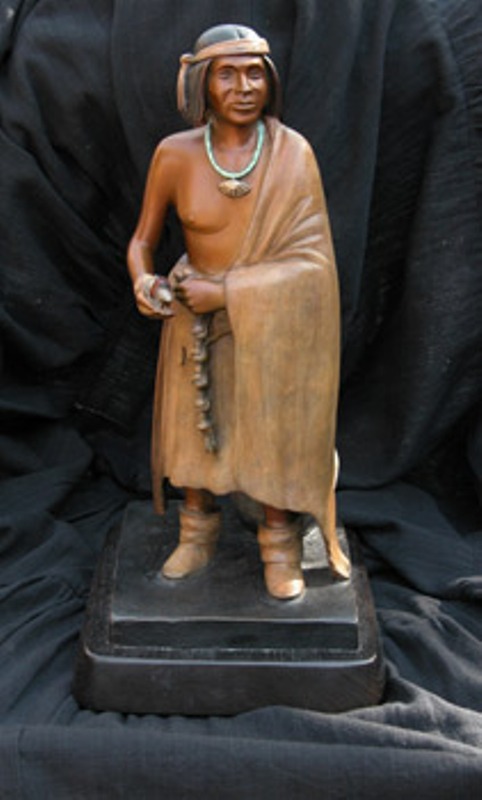 |
    
Ld
Username: Ld
Registered: 01-2007
| | Posted on Thursday, August 19, 2010 - 04:45 pm: | |
琵琶湖畔的风物在紫式部细腻的笔下,是何等的静美动人:“淡淡的秋意,别具一番难以言表的情趣。湖畔的树梢,渠边的草丛,既星缀了点点枯黄,傍晚的天空也在晚霞映照下显得格外亮丽与深邃。晚风渐凉,夜色渐浓,周围渐由朦胧而幽暗,渠水的低吟与彻夜的诵经声和谐相融,让人不辨彼此。”难怪滋贺人都骄傲地说,琵琶湖是这部『日本的文学名著《源氏物语》』鸿篇巨制的灵感源泉。
http://blog.sina.com.cn/s/blog_50d2c22e0100io3h.html
http://cn.explore.ne.jp/jp-mp/cihe/jinjiang8.php
日本“近江八景”:洞庭湖“潇湘八景”的姐妹篇
易播乐中文 编辑部
像中国一样,日本各地也有各种各样的“八景”。而滋贺县的“近江八景”则是日本各地的“八景”的肇始。
“近江八景”是以中国洞庭湖的潇湘八景为模型选定的。
关于选定者,有的说是明应9年(1500年)逗留近江的公家近卫政家,有的说是庆长年间(1596~1614)的关白近卫信尹;还有的说是室畸后期访问近江的僧人,因为憧憬中国的“潇湘八景”,依葫芦画瓢,选出了当地的八景。最后一种说法被认为可能性最大。
17世纪后期以降日本出现了许多“近江八景”的绘画。有“浮世绘第一人”之称的安藤广重的《近江八景》是其中最优秀的一组。该作于天保5年(1834年)由荣久堂、保荣堂共同出版横大判锦绘版,赢得广泛的人气。安政4年(1857年),又由鱼荣(鱼屋荣吉)出版竖大判锦绘版,总共印行了20多次,进入了庶民阶层并为他们所喜欢。

石山秋月Ishiyama 安藤广重 作
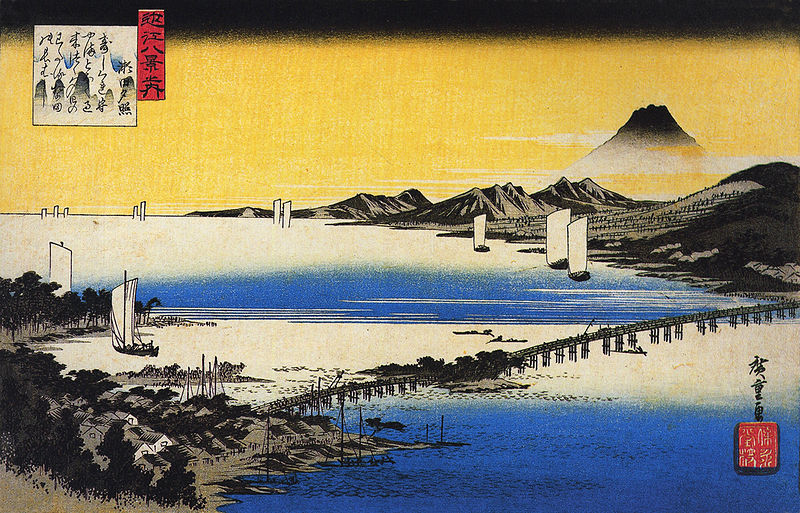
濑田夕照Seta 安藤广重 作
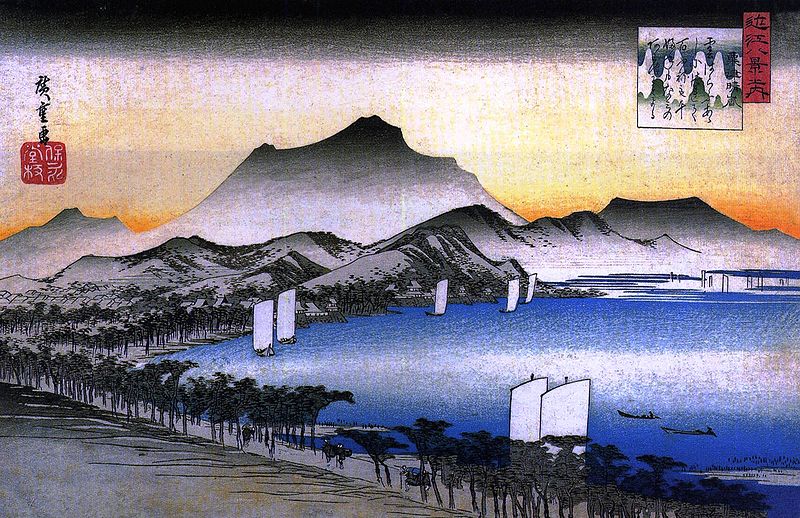
栗津晴岚Awazu 安藤广重 作
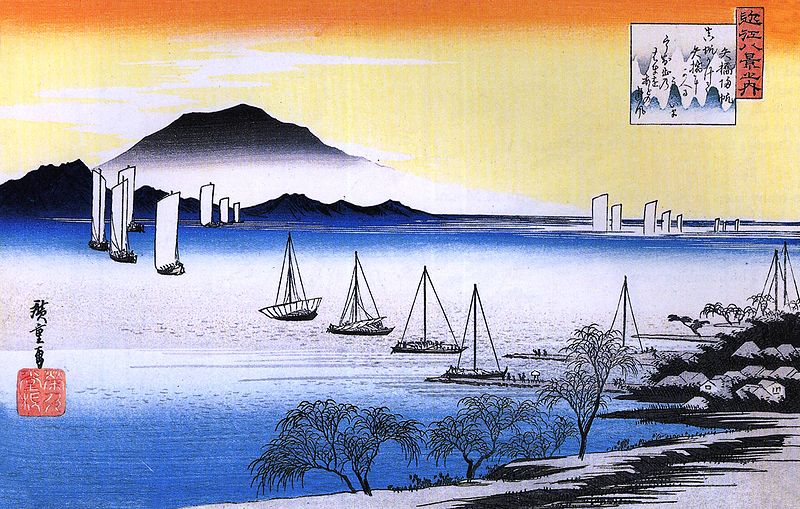
矢桥归帆Yabase 安藤广重 作
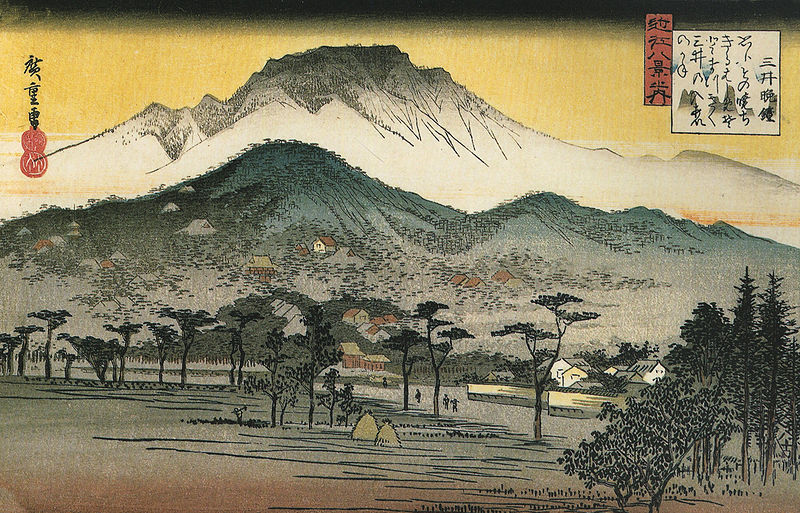
三井晚钟Mii Temple 安藤广重 作
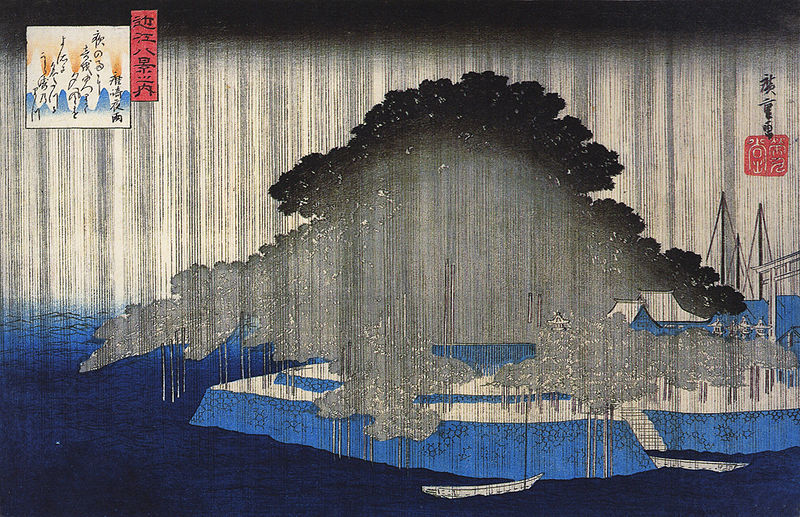
唐崎夜雨Karasaki 安藤广重 作
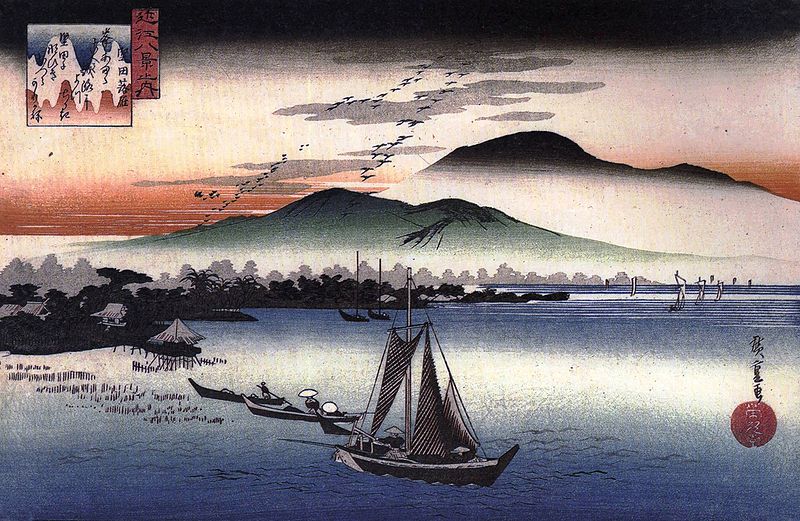
坚田落雁Katata 安藤广重 作

比良暮雪Hira Mountains 安藤广重 作
●1949年新选出的“琵琶湖八景”
* 月明 彦根 之古城
* 凉风 雄松崎 之白江
* 新雪 贱岳 之大观
* 烟雨 比叡 之树林
* 深绿 竹生岛 之沉影
* 夕阳 濑田 ・ 石山 之清流
* 晓雾 海津大崎 之岩礁
* 春色 安土 ・ 八幡 之水乡
近江風情畫
http://blog.udn.com/lunhua168/1663823
===========================================
Biwako Aika琵琶湖哀歌 (Lake Biwa Elegy)
http://photoguide.jp/txt/Biwako_Aika
The song was written by Katata-native Okuno Yashio (1902-1981) 奥野椰子夫 and music composed by Kikuchi Hiroshi 菊地博. The music has similar notes to Biwako Shuko no Uta which was created earlier in 1917. Biwako Aika was released as a record in June 1941, sung by Shoji Taro (1898-1972) (東海林太郎) and Ogasawara Mitsuko (1920-) (小笠原美津子) and became a national hit.
http://www.youtube.com/watch?v=kvxHrNEHc4I&feature=related
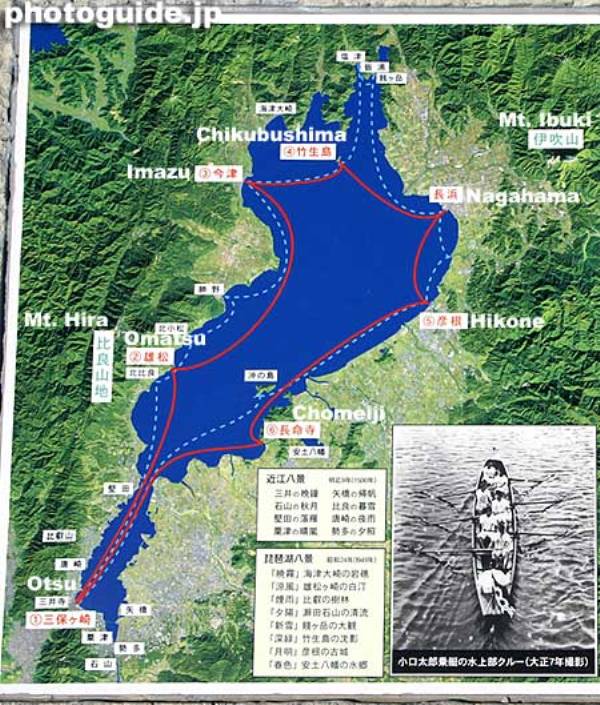
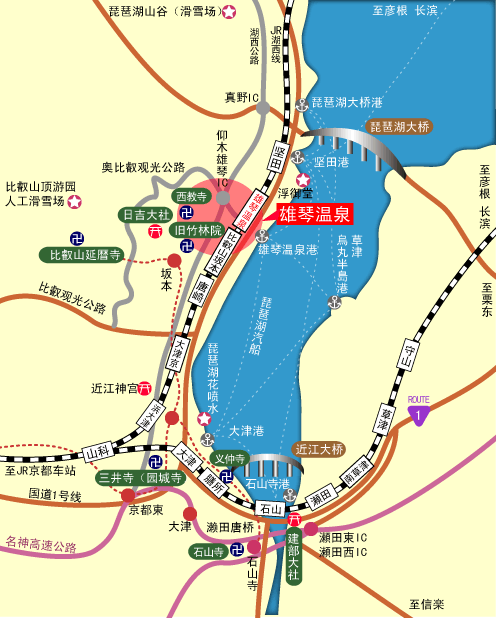
Biwako Shuko no Uta (琵琶湖周航の歌)
Lake Biwa Rowing Song
http://www.youtube.com/watch?v=uH3mtrS3xWo
http://photoguide.jp/txt/Lake_Biwa_Rowing_Song
http://www.youtube.com/watch?v=gZeei8pEdLA&feature=channel
Lake Biwa Rowing Song
Lyrics: Tarou Oguchi Music: Chiaki Yoshida
We're child of the lake, off to wander'round
This journey fills my heart with, intense happiness
Rising mist evaporates, ripples come and go
Shiga's Miyako dear, bid farewell for now
Pine trees are very green, on sands very white
Omatsugasato is, a young maiden's home
Bush of red camellia, hides her teary face
She's weeping o'er a lost love, much too short to last
We drift from wave to wave, straying aimlessly
On shore we see red fire, brings back memories
With our sights set nowhere, rolling with the waves
Today is Imazu or, Nagahama huh
Azure blue flower garden, revered coral shrine
Full of old-time stories,Chikubushima
In the hands of Buddha, one young maiden lies
She's sleeping in compassion, resting peacefully
Sharp arrows buried deeply, way into the ground
Abundant summer grasses, a moat still remains
Standing in an old castle, all alone oneself
Hira and Ibuki too, only but a dream
Saigoku pilgrimage, Chomeiji
Dispel this world's impureness, very faraway
Golden waves on which we weave, rowing all we can
Tell us my friends your stories, with your fervent hearts
琵琶湖泛舟之歌
小口太郎 作词 吉田千秋 作曲
我是琵琶湖的孩子 泛舟湖面是我的最爱
满怀激动地站在湖边挥挥手
作别那烟波缭绕中志賀之都的云彩
苍劲的雄松点缀于白沙之上
松尾尽头 那是位少女的故乡
姹紫嫣红的山茶花丛里
仿佛留有她为爱而忧伤的脸庞
我们的小舟随波逐流于晚風中
在星光点缀的灯火下 远处分外通紅
逐渐地我们回到了记忆的深处里
无论清晨是到今津还是长滨
琉璃般的花园中有座珊瑚环绕的神社
那里就是竹生岛 充满了很多古老的传说
在佛像的手掌中 一个小女孩进入了梦乡
她睡得是多么地平静而祥和
逝去的烽烟逐渐被淹没于尘土之下
曾几何时 宽阔的护城河成了荒草之家
只有孤独的古城
和比良山,伊吹山一起
依旧映照着晚霞
西国十番的圣地长命寺
也慢慢地淡没于视野之外
夕阳映照下 我们在湖面划出了金色的浪花
朋友 这些就是我们要告诉给你的
并请你用心去聆听它
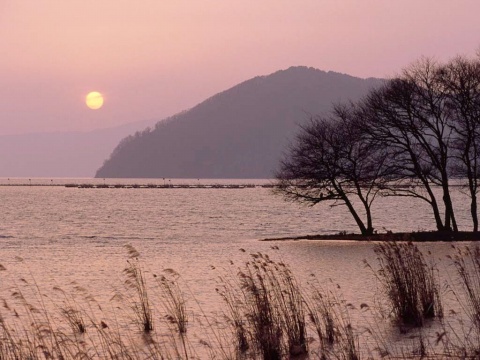
==========================================
東海林太郎
http://zh.wikipedia.org/zh-tw/%E4%B8%9C%E6%B5%B7%E6%9E%97%E5%A4%AA%E9%83%8E
(1898年12月11日-1972年10月4日),1936年起從職歌手。一直以來以其直立不動一本正經的演唱方法贏得了日本國民的喜愛,尤其為戰前最具代表性的歌手。
............
........
但是在戰爭結束之後,因為戰時暢銷的某些曲目關係到太多所謂的「軍國主義思想」被列入黑名單並遭到禁止。被禁駐軍監視的低調時代由此來臨。1946年,菲利普公司重新恢複發售的由其演唱的第一部作品為《永別了,赤城喲》。1949年,重歸國王唱片公司。1953年,轉入日本水星唱片公司。
◆◇◆◇◆◇◆◇◆◇◆◇◆◇◆◇◆◇◆◇◆◇◆◇◆◇◆◇◆ |
    
Ld
Username: Ld
Registered: 01-2007
| | Posted on Thursday, August 19, 2010 - 04:43 pm: | |
琵琶湖畔的风物在紫式部细腻的笔下,是何等的静美动人:� �淡淡的秋意,别具一番难以言表的情趣。湖畔的树梢,渠边� ��草丛,既星缀了点点枯黄,傍晚的天空也在晚霞映照下显得 格外亮丽与深邃。晚风渐凉,夜色渐浓,周围渐由朦胧而幽� �,渠水的低吟与彻夜的诵经声和谐相融,让人不辨彼此。”� ��怪滋贺人都骄傲地说,琵琶湖是这部『日本的文学名著《源 氏物语》』鸿篇巨制的灵感源泉。
http://blog.sina.com.cn/s/blog_50d2c22e0100io3h.html
http://cn.explore.ne.jp/jp-mp/cihe/jinjiang8.php
日本“近江八景”:洞庭湖“潇湘八景”的姐妹篇
易播乐中文 编辑部
像中国一样,日本各地也有各种各样的“八景”。而滋贺县� �“近江八景”则是日本各地的“八景”的肇始。
“近江八景”是以中国洞庭湖的潇湘八景为模型选定的。
关于选定者,有的说是明应9年(1500年)逗留近江的公家近 卫政家,有的说是庆长年间(1596~1614)的关白近卫信尹;还有� ��说是室畸后期访问近江的僧人,因为憧憬中国的“潇湘八景 ”,依葫芦画瓢,选出了当地的八景。最后一种说法被认为� �能性最大。
17世纪后期以降日本出现了许多“近江八景”的绘画。有“ 浮世绘第一人”之称的安藤广重的《近江八景》是其中最优� �的一组。该作于天保5年(1834年)由荣久堂、保荣堂共同出� �横大判锦绘版,赢得广泛的人气。安政4年(1857年),又由� �荣(鱼屋荣吉)出版竖大判锦绘版,总共印行了20多次,进� �了庶民阶层并为他们所喜欢。

石山秋月Ishiyama 安藤广重 作

濑田夕照Seta 安藤广重 作

栗津晴岚Awazu 安藤广重 作

矢桥归帆Yabase 安藤广重 作

三井晚钟Mii Temple 安藤广重 作

唐崎夜雨Karasaki 安藤广重 作

坚田落雁Katata 安藤广重 作

比良暮雪Hira Mountains 安藤广重 作
●1949年新选出的“琵琶湖八景”
* 月明 彦根 之古城
* 凉风 雄松崎 之白江
* 新雪 贱岳 之大观
* 烟雨 比叡 之树林
* 深绿 竹生岛 之沉影
* 夕阳 濑田 ・ 石山 之清流
* 晓雾 海津大崎 之岩礁
* 春色 安土 ・ 八幡 之水乡
近江風情畫
http://blog.udn.com/lunhua168/1663823
===========================================
Biwako Aika琵琶湖哀歌 (Lake Biwa Elegy)
http://photoguide.jp/txt/Biwako_Aika
The song was written by Katata-native Okuno Yashio (1902-1981) 奥野椰子夫 and music composed by Kikuchi Hiroshi 菊地博. The music has similar notes to Biwako Shuko no Uta which was created earlier in 1917. Biwako Aika was released as a record in June 1941, sung by Shoji Taro (1898-1972) (東海林太郎) and Ogasawara Mitsuko (1920-) (小笠原美津子) and became a national hit.
http://www.youtube.com/watch?v=kvxHrNEHc4I&feature=related

mage{The Eight Views of Omi10.jpg}
Biwako Shuko no Uta (琵琶湖周航の歌)
Lake Biwa Rowing Song
http://www.youtube.com/watch?v=uH3mtrS3xWo
http://photoguide.jp/txt/Lake_Biwa_Rowing_Song
http://www.youtube.com/watch?v=gZeei8pEdLA&feature=channel
Lake Biwa Rowing Song
Lyrics: Tarou Oguchi Music: Chiaki Yoshida
We're child of the lake, off to wander'round
This journey fills my heart with, intense happiness
Rising mist evaporates, ripples come and go
Shiga's Miyako dear, bid farewell for now
Pine trees are very green, on sands very white
Omatsugasato is, a young maiden's home
Bush of red camellia, hides her teary face
She's weeping o'er a lost love, much too short to last
We drift from wave to wave, straying aimlessly
On shore we see red fire, brings back memories
With our sights set nowhere, rolling with the waves
Today is Imazu or, Nagahama huh
Azure blue flower garden, revered coral shrine
Full of old-time stories,Chikubushima
In the hands of Buddha, one young maiden lies
She's sleeping in compassion, resting peacefully
Sharp arrows buried deeply, way into the ground
Abundant summer grasses, a moat still remains
Standing in an old castle, all alone oneself
Hira and Ibuki too, only but a dream
Saigoku pilgrimage, Chomeiji
Dispel this world's impureness, very faraway
Golden waves on which we weave, rowing all we can
Tell us my friends your stories, with your fervent hearts
琵琶湖泛舟之歌
小口太郎 作词 吉田千秋 作曲
我是琵琶湖的孩子 泛舟湖面是我的最爱
满怀激动地站在湖边挥挥手
作别那烟波缭绕中志賀之都的云彩
苍劲的雄松点缀于白沙之上
松尾尽头 那是位少女的故乡
姹紫嫣红的山茶花丛里
仿佛留有她为爱而忧伤的脸庞
我们的小舟随波逐流于晚風中
在星光点缀的灯火下 远处分外通紅
逐渐地我们回到了记忆的深处里
无论清晨是到今津还是长滨
琉璃般的花园中有座珊瑚环绕的神社
那里就是竹生岛 充满了很多古老的传说
在佛像的手掌中 一个小女孩进入了梦乡
她睡得是多么地平静而祥和
逝去的烽烟逐渐被淹没于尘土之下
曾几何时 宽阔的护城河成了荒草之家
只有孤独的古城
和比良山,伊吹山一起
依旧映照着晚霞
西国十番的圣地长命寺
也慢慢地淡没于视野之外
夕阳映照下 我们在湖面划出了金色的浪花
朋友 这些就是我们要告诉给你的
并请你用心去聆听它
mage{The Eight Views of Omi11.jpg}
==========================================
東海林太郎
http://zh.wikipedia.org/zh-tw/%E4%B8%9C%E6%B5%B7%E6%9E%97%E5%A4%AA%E9%83%8E
(1898年12月11日-1972年10月4日),1936年起從職歌手。一直以� ��以其直立不動一本正經的演唱方法贏得了日本國民的喜愛, 尤其為戰前最具代表性的歌手。
............
........
但是在戰爭結束之後,因為戰時暢銷的某些曲目關係到太多� �謂的「軍國主義思想」被列入黑名單並遭到禁止。被禁駐軍� ��視的低調時代由此來臨。1946年,菲利普公司重新恢複發售� �由其演唱的第一部作品為《永別了,赤城喲》。1949年,重歸 國王唱片公司。1953年,轉入日本水星唱片公司。
◆◇◆◇◆◇◆◇◆◇◆◇◆◇◆◇◆◇◆◇◆◇◆◇◆◇� �◇◆ |
    
Ld
Username: Ld
Registered: 01-2007
| | Posted on Saturday, March 13, 2010 - 05:41 pm: | |
http://www.digicamhelp.com/taking-photos/lighting-techniques/low-light-focus.php
Low light focusing
Focusing a digital camera in low light can be challenging, even if a camera has an autofocus assist lamp. But the main culprit of misfocused images is usually caused by low contrast, not low light.
Look for contrast
When having difficulty focusing in low-light, lock focus and exposure on something in the scene that has contrast. It should be of equal distance and lighting as the main subject. Point the camera's focus indicator on the area with contrast, depress the shutter-release button half-way and confirm focus. You may need to move the camera around a few times before achieving focus lock. Once focus is confirmed, reframe the scene and fully depress the shutter button. This technique works best when a camera is set to a single area focus mode.
Misfocus or blurred images?
Sometimes a photo that appears misfocused is actually blurred because of camera shake due to slow shutter speed. When lighting is low, the aperture opens wider to let in more light. The larger the aperture opening, the slower the shutter speed. Few people can hold a camera steady when shutter speeds are below 1/60th of a second, especially if the camera doesn't have image stabilization.
Increase shutter speed by increasing the light on the subject. Let more light into the room, turn on more lights or use the flash.
You can also increase camera sensitivity by using a higher ISO number. The downside is that higher ISO numbers can cause image noise, with a resulting loss of detail. Fortunately, noise can be reduced with noise reduction software.
Use a tripod or other support to keep the camera from moving. If not possible, hold the camera as steady as you can.
If your camera has a viewfinder, use it rather than the LCD to frame shots. Pressing the camera against your face helps minimize movement. If your camera doesn't have a viewfinder, learn how to frame a shot using the LCD. |
    
Ld
Username: Ld
Registered: 01-2007
| | Posted on Saturday, March 13, 2010 - 12:51 pm: | |
http://zhidao.baidu.com/question/11278444.html
呵 , 崖门
陈占标
崖门,在新会南端,面临南海,是西江支流与潭江汇合出海口。口岸西有汤 瓶山、东有崖山对 峙如门,
因称崖门。
到过崖门游览的人,都会享受到这里的大自然美。呵,崖门,你确 实 瑰丽。站在高处眺望,烟波浩瀚的
南海,无际无边,水天一色;近处,山峦叠翠,夹着银洲 湖水滚滚南流,气象万千。然而,崖门不仅以风景
著称,更重要的是以峻险取胜。在珠江三 角洲的河流水域地带中,崖门与虎门实为西部与东部的屏障。这地
方,依山临水,踞高临下 ,易守难攻,历来被兵家视为海防咽喉之地。"远望崖门气势雄",郭沫若同志描绘
崖门形 胜的诗句,完全没有夸张。
呵,崖门!你以得天独厚的优越环境,被历史造就成为 一个举 世瞩目的宠儿。是南宋王都,是古战场,
是元宋兴亡的见证。"凭吊先朝一涕零",多少游 人为你洒出一掬同情之泪。
海水汹涌奔流,后浪推击前浪。此刻,我的思绪,走 向历史的 深渊;我的眼底,涌现历史的画卷;我的
心扉,接收历史的回声……
700年前,就在崖门 海,发生一场震古铄今的鏖战。元将张弘范、李恒率领新兴气锐蒙古军,追逐围攻从
硇洲迁 来崖山的南宋小皇帝。宋将张世杰、丞相陆秀夫的20万宋军,为保卫赵家王朝与元兵一决死 战,战斗
就象马拉松式在崖山周围剧烈展开。最后,宋室君臣士卒被迫退至崖门海中,以船 为垒,凭舟啬死 守。"楼
船千艘下天角,两雄相遇争夺搏",文天祥这样描写这场发生在祥兴二年(1279年) 二月初六日在崖门、浮尸十
万的海上厮杀:"一朝天昏风雨恶,炮火雷飞箭星落。"战争以 元 兵大败宋军而结束,丞相陆秀夫背负小皇帝
蹈海,南宋遂亡。这是一页南宋覆灭的悲痛史, 在当时,也称为是一幕民族悲痛的历史,古时也称亡国史。
汉族人民历来抱着传统的民族 感情,几百年来,人们吟出多少悲壮的、憾人肺腑的诗篇?脍炙人口的,有陈献
章的"世乱 英雄终死国",清初陈恭尹的"两崖波浪至今悲",民国时莫子青的"谁挽崖门既倒澜"。 直至解放后
,前广州市市长朱光还吟出"崖门我亦低回久"呢。在这里,民族气节得到充分 的发扬;国破家亡的呻吟得到
尽情的发挥,而爱国主义的激情将会撞击人们的心灵,爱国主 义的精神将会发扬光大!
历史,如烟如雾。往事,瞬即消逝。然而,历史遗迹却永远使人 追忆。在崖门古战场千秋功罪评说中
,"奇石"算是最好的见证。
"奇石",原是崖山附 近海边突出海面的两条石柱,古有"波心之石生奇绝,凌空屹立势如飞"之说,看来
是有点 夸张。此石何以称"奇石"?也许是宋帝丙在此石附近沉海吧?其实不然。此石奇就奇在给人 利用来摆功
,因而发生一场"抑*扬忠"的戏剧性故事。
原来,元朝大将张弘范为了表 彰 自己灭宋之功,竟在"奇石"上镌刻了"镇国大将军张弘范灭宋于此"十二
个大字。这一来 ,骂张弘范的人就多了。元末明初,邑人张扌为 年仅18岁,写过一首《崖门怀古》,就有
"摩崖共说张弘范 ,把酒唯浇陆秀夫"的警句,抑*扬忠,褒贬分明。明代中叶,广东提学使赵瑶骂张弘范"
忍夺中华与外夷",是个背叛民族的卖国贼。当御史徐瑁来游崖门,目睹奇石的张弘范的记 功字刻,立即命人
铲去,净化环境。陈献章、赵善鸣等拟另刻字于奇石,终因意见不一而未 果。几成为一桩"悬案"。
"奇石"后来没有刻上字的另一个原因,是星移物换,海水涨 落发生了变化,"奇石"像个怕羞的黄花少女
不再轻易露出水面了。解放初,我乘船运粮经 过银洲湖,问起船家"奇石"在哪里?船家告诉我:"那奇石,平
日难得见。只有农历12月2 0日下午2时,潮水退至最低的水位才能见到口罗 !"一年之后,听说航管部门清
理河道,把"奇石"当作" 暗礁"而炸毁,十分可惜。
现在在官冲沙村海旁那像蒙古包似的"奇石"是代替品。只是 由于六十年代初,著名戏剧家田汉来游,书
写"宋少帝与丞相陆秀夫殉国于此"十三个字, 镌刻于石上,人们再也不会怀疑这"奇石"的真实性了。
崖门古战场还有很多遗迹、遗物 ,如祠、庙、亭、殿和碑刻等等,虽经历劫,尚有幸存。解放后,从
1959年开始,至今已重 建有崖山的慈元殿、大忠祠、义士祠、石门楼以及复原的十多块旧碑石刻。此外,还
修建了 "杨太后陵"和"白鹇冢"等古迹文物。琉瓦飞檐的古建筑,掩映在绿树丛中,增添了崖山 的秀丽和肃穆
。然而,在这些古迹群体当中,令人最敬仰的要算"天地正气亭"了。亭中矗 立一块竖身大石碑,内刻宋丞相
文天祥当年在崖门口舟上作的《过伶仃洋》诗句:"人生自 古谁无死,留取丹心照汗青"。它把人们的思想引
到崇高的境界中去啊!
啊,崖门!数百 年 来,古战场已成为爱国主义教育的大课堂;近代在海边山岩上建筑的炮台,则成为抵
御外来 入侵的骄傲象征!
崖门海防,宋有戌寨、明筑东、西炮台。明末清初,镇慑倭寇骚扰,发 挥很大作用。现今的崖门炮台,
建于清嘉庆年间,历经重修,保存尚好。炮台前临大海,后 枕山丘。环筑如城堞,呈半圆形状,极为壮观。
入口处有"镇崖台"题额,外向有"炎海风 清"四字,为咸丰年间新会知县陈应聘所书。登上周十八丈、高一丈
三的炮台顶层,瞩目眺 望,只见崖海茫茫、古兜苍苍,炮台雄踞崖边,虎视狂澜通道。此刻,我想起史书的
记载: 150年前鸦片战争的前夕,林则徐运筹帷幄,决策千里,为防范英国侵略军从崖门水道进入 内地,他
预先派兵驻守崖门炮台,在上下两层四十五号炮位,分置二千、三千、四千斤重的 铁炮,随时迎击入侵的敌
军。这样,使得英军望风而遁,不敢越入崖海雷池半步,从而保 障四邑侨乡的安宁。
此后,崖门炮台一直成为四邑海防的屏障。时间推移至四十年代,抗 战期间,中国共产党领导的抗日游
击队,就是凭借崖门的天险而进行打击日伪军的活动。
解放后,崖门依然是新会县的海防前哨。崖内银洲湖水域,湖阔水深,是理想的军事良港, 最适宜舰艇
的锚泊。在防卫力量加强的同时,先后又建立镇政府的行政机构,相应地成立公 安、缉私、民兵武装等部门
,把守着南大门,随时打击敌人的侵扰。1962年11月1日凌晨, 台湾当局在反攻大陆的叫嚣声中,曾派遣匪
特"海威训传班"第6分队一小股,驾驶船艇潜 来骚扰,当场被我人民海军全歼于崖门海,计毙匪特9人,俘获
26人,缴获橡皮船1艘,物资 一批。我人民海军战士英勇无畏,心红似火,他们像崖门炮台里那高耸的木棉树
,凌空挺立 ,光照海空。英雄的战士足堪与英雄花相媲美啊!
改革开放后,祖国的社会主义建设飞跃 发展,啊,崖门,你又跨进新的历程,加入经济建设的行列。崖
门渔港建立起来了,站在高 处了望,一条条崭新的防浪石堤和护岸堤,像白绸、像白壁蜿蜒而伸,捍卫着田
畴村落;避 风港和沿岸码头,同一时候可以分别容纳百余艘渔船和二十余艘大渔船,为渔民作业提供了 保险
。这里经常可见樯杆林立,船艇鳞次栉比;船舱里的鳞光闪闪的鱼,蹦跳的虾,横窜的 蟹……呵,简直是水
族世界。
随着渔业生产的发展,冷冻厂、渔船修理厂、自来 水 厂、油库……等等现代化设施建设起来了。
呵,崖门!你不仅是南海滨的海防要冲,而且 ,已成为新会经济建设的场所。展望未来,凭借你天然的环
境和丰富的资源,将会成为珠江 三角洲中的一颗璀灿的明珠!成为大金三角里的小金三角!
初读银洲湖
孙丹霞
来新会一年后终于有机会去银洲湖--南宋末代皇帝跳海的那片湖。当我来到崖山奇石旁,辽阔 的湖面无
声地呈现在眼前时,我立刻被这宏伟慑住,忘了呼吸。面对被誉为"中国第二个兵 马俑"的银洲湖,我只想用
足力气大喊一声,然后吐出一腔鲜血来祭奠我的祖先。我小心地 走到毫无人工修饰的岸边,似乎听到了千百
年的激愤的怒吼声,我深深地感觉到初见却似熟 悉的亲切,是因为湖水就嵌在我的心里,我将手缓缓探入湖
中,开始领悟它汹涌的内容,澎 湃的情思,伟大而深邃的哲理。
1279年汉人张弘范率兵追击宋军至崖山,南宋军民浴血奋 战兵败崖海。10万军民浮尸水面,丞相陆秀夫
背负年仅8岁的赵日丙皇帝及传国玉玺在这块石 头上蹈海殉难……这湖太小,那死去的魂灵现今仍拥满了湖
底湖面,难怪不见浪花喧笑了。 死,作为人类必然的生理归宿,总令人生畏,但是,葬身涡流也有着千百种
价值啊!掬一捧 湖水,已无法再寻找一具实在的躯体,但却分明触摸到10万个宁死不降的灵魂。
我被浸透 ,被洗涤,我似乎读懂了这蓝色的启示录。李白醉酒跳江捞月,留下让世人传诵的诗篇;屈 原
抱石投江,以死体现生命不屈的另一种形式。还有意志坚韧近似愚笨的衔树枝填海不止的精 卫 鸟。我淡淡地
笑了,心脏却痉挛般抽搐。在赤裸的银洲湖边,我也赤裸地真实了自己。深藏 于现代人心底的悲哀--标榜自
我却日胜一日地丧失了自我。在用奔驰车、俱乐部会员卡、 职称、地位来标志自我的今天,我的内心会平静
吗?初来广东时的种种委屈和不如人意,此 刻荡然无存,因为这浸满英灵的湖水已将一切包容,同化、同归了
。这里吞噬了虚荣,帝王 与士兵同葬,所有的历史辉煌都不能再与银洲湖比沧桑。个人成败得失又算得了什
么,数十 年的人生在宇宙的时空中只是一瞬,永恒的力量属于银洲湖的神韵。
啊!如果时空也有黑发,我愿让历史老人为我重新洗礼。
隐约中我听 到了南国5月天太阳清脆的铃声,湖底亦 响起朦胧的音乐。就在此时此刻,我预感到神奇的
变化将在身上发生,那种几乎被我丢弃的 纯真又重归了,而在近几年似流行病样可憎的却又无法摆脱的毒瘤
消失了。我的身心在扩大 延伸,同天同海,同躲藏的星月连成一片。
哦,银洲湖,在风雨岁月中曾有江河带着泥沙 染污过你的蔚蓝,也曾有狂风带着大陆的尘埃挑衅过你的
壮丽。然而你还是你,依然波澜壮 阔,依然清新秀丽,这是因为你具有举世无双的沉淀力与排除力,顽强地
进行自我更新。
当夕阳染红最后一抹白云,我向银洲湖告别。再见,银洲湖,我不能一次读完你,一生也无 法读尽你丰
富而博大的内涵,我还会再来。
古炮台上颂红棉
胡 伟
新会南端的崖门--西江、潭江出海处,雄踞着一座古炮台,其壁面是厚厚的苔藓,坦围内长满 了杂草灌
木。不知哪年哪月,两株木棉破土而出。或许自幼就经受风雨的洗礼和浪涛的震撼 ,淡棕色的树干变得粗犷
而挺拔,挣脱了灌木荆棘的束缚,出类拔萃,苍劲耸立,显现出奋 发向上的英雄气概。枝桠也很争气,长得
干脆利索,不弯腰,不献媚,似铮铮铁骨。木棉的 花朵虽没有牡丹的娇丽,也没有秋菊的姿色,但却为人所
仰慕;它那深褐的花蒂紧裹着五片 大红花瓣,中间团聚着一束箭镞似的花蕊,近看犹如一团团燃烧的烈火,
远望宛然一片片璀 璨的红霞。由于木棉树和木棉花的形态和风格恰似人们心中的英雄,因而有"英雄树"和"
英 雄花"的美誉。
春末夏初,正值木棉花开的季节,我满怀幽思,来到崖门炮台。极目远眺 ,只见天水浑然,海水的交汇
与碰撞,激起白浪千堆,冲刷着炮台脚下的石壁,洗刷着历史 沉戈,仿佛在诉说那个新会人永远讲不完的故
事……
这里确有悲壮的故事。七百多年前, 元军攻陷宋朝都城临安,帝、后、王、臣几乎被俘虏。宋臣陆秀夫
、文天祥、张世杰率十多 万官兵遗民,护宋帝二子赵日正、赵丙 一路南逃,并拥赵正为帝。不到两年,帝
正病死,赵丙为帝,又迁移至 新会崖门,凭借崖海天险抵御追兵,以图他日东山再起。崖海鏖战,烽火连 天
,宋军被困数月,沉船数以百计。左丞相陆秀夫见大势已去,便奏明万岁:"国事至此, 陛下当为国死,不可
受辱。"于是,背起年仅九岁的南宋最后一位皇帝投海殉国,其他遗臣 残兵,纷纷效法,壮烈牺牲。正是"曷
来南海上,人死乱如麻。腥浪拍心碎,飚风吹鬓华… …"文天祥的哀诗令人心酸,但他那"人生自古谁无死?留
取丹心照汗青"的千古名句又着 实令人感奋。
宋末"三忠",为后人所赞颂。几百年来,不知多少人前来这古战场凭吊。 而今的我,抚摸着高大的英雄
树干,仰望着似火的红棉花簇,一股对我们民族英雄的敬慕之 情油然而生。在他们身上,我感受到我们民族
的骨气--像红棉一样,深深扎根于土壤之中 ,勇于向上。敢于抗争,不屈不挠地屹立于荆棘丛中!
崖门炮台里的两棵木棉,经历了悠 长的岁月,经受着风雨的洗礼,是英雄的化身,更是沧海桑田变迁的
见证。当年腥风血雨的 银洲湖两岸,如今呈出一派欣欣向荣的景象。绿野葱葱,路桥畅通,新城与厂房拔地
而起, 掩映于婆娑葵林;谷物与瓜果常年丰盛,飘香于田园山间。湖面上,不知疲倦的船只耕起了 道道骄傲
的浪痕……好一幅彩艳美景,是新会人用心血所绘画;好一份荣光自豪,是新会人 以艰辛所换取。然而,他
们并不自满。他们要面对的是充满挑战的未来,而为了更美好的未 来,他们正以勇气、智慧和坚毅接受着挑
战。"将军树作蓝天柱,毕竟英雄是木棉。"奋进 吧,新会人!圭峰是你的后盾,西江和潭江是你的脉流,你有
红棉的气质,你有英雄的本色!
寻访禾雀花
曾 燕
听说禾雀花都聚到新会棠下蓬莱山的公坑里来了,为一睹万鸟栖枝,百鸟和鸣的盛景 ,冒着悄然无声的
清明雨,来到蓬莱山脚。
入牌坊,末闻鸟声,便有一股清泉从脚边"呼 啦"蹿过。那清凉,也由上而下直贯全身。歇脚"听泉亭",
身心被冰凉的泉水哗哗冲洗, 顿觉恬然。泉水自树根盘错的磊磊石壁间涔然而出,在"龙头岩"小蓄,经大龙
头吐出,两 个小龙头又吞而吐之,汇成溪水,溪行空岩中,声音朗朗。宛如众书童在谷里读书,绵长不 息。
水在环形的溪涧里迥旋打转。水中的小动物"水黄茑、无笃螺、煎浓虾"也跟着在水湾 湾里翻滚。溪边立一大
石,刻着"藤缠树兮,花是鸟"藤葛似的大字。体态娇柔,一脸脂粉 ,仿如古原荒野之地立着浓妆娇媚的迎宾
女仪。
抬眼上望,竹树浓荫,杂树相抱而生。在 翠竹与古树之间,由腕粗的绿藤引领,在山谷蜿蜒走着。纵横
交缠,层层相攀,把整个山谷 绕成个天灵盖儿,又象个大蒙古包。唯顶端洞开一天窗,漏些阳光进来。藤蔓
在瘴雨蛮烟里 勾肩搭背,如同一群结伴春游的少女,在田野扭打、嬉闹,扰乱了春天的秩序。那绿藤上隔 三
差五的站着 倦透了的禾雀,干瘪的身躯仍固守藤间,痴等铁拐李的释放咒语,地上却铺满停止拍动的翅 膀和
啼干的嘴巴,想是为了飞出这绿色的囚笼而拼落一地羽毛,身首异处。香魂却钻进出那 一指洞天,飞向广阔
的天空。我轻抚一只刚折翅膀的花仙子,道了一声,我来迟了。便将它 放于溪水中,让流水把它带出去,圆
了飞向新天的梦。
禾雀花何以专拣这山幽水静的山谷 闯,并作巢绿色的天帐,不愿离去?据传,很久很久以前,有一种鸟专
食禾穗,名曰禾雀。 每年用它们的尖嘴巴糟蹋了不少稻子,令农民兄弟大为头痛。仙人铁拐李云游至此,见
鸟害 为患,遂施法术把禾雀缚于绿藤中弃于蓬莱的公坑,只许每年青黄不接的清明时节出来。每 当春雨绵绵
便有成千上万有眼、有翅、有尾、若不小心碰伤了还会流出鲜血、白里微黄的花 仙子,鸟精灵现于山谷。一
串串昂首挺胸,拍动双翅,谛听谷外的风声、雨声,飞鸟相唤声 ,无奈脚爪却钉在绿藤上动弹不得。偶有山
风吹过,仿如千万只生蹦乱跳的禾雀跃于绿屏上 ,虽不能再抢食禾穗,却也闹得一谷山水不得安生。引得人
们放着那热烈的摇滚不蹬,潜入 宁静的谷地,让青山绿水洗涮城市积垢,寻攀在藤蔓上的禾雀,传说中的主
人公。
人们对 某种异样的生物,总爱打上自己认识的烙印,编一段凄艳的与自然斗争的故事,以掩饰自己 的无
知和显示自己的实力。怎知这禾雀在古藤上站了千年,喙破多少苍然岁月。其实山是山 ,水是水,草木有其
自己的语言,鱼儿鸟儿自有翔游的技能,蜂儿自有采花酿蜜的本领,它 们的生存技能是人类所难以企及的,
在各自的王国里他们都是主角,有其约定俗成的宪章, 自已的地盘。它们承天地之灵气,应和四季变化,快
快乐乐的生活,自自由由地游戏,构成 一块块独特的生物块,紧紧贴在地球上,生生不息姿采纷呈。大地才
有声有色,五彩缤纷。 人走在路上才不觉得寂寞。倘若地球是人类的家,这个家前院有绿水常绕青山转,后
院有绿 荫百花开,上有飞鸟彩蝶舞春风,下有鱼虫畅游。多好!
循水声踏着长有苔藓的山石而上 ,山腰有一古朴小巧的寺院,称"天成禅院",又名"公坑寺",据闻为宋
末僧人安身修佛 之 所。寺内供奉着笑口常开的弥勒佛,只见他腆腹袒胸,双手擎天,一副天塌下来他顶住的
架 势,呵呵的笑向众生。身边有副对联:"肚大能容容天下难容之事,口开常笑笑世间可笑之 人"。向世人昭
示了"有容乃大,有容乃笑"的天机。"公坑寺"立而受命,看管着千万只 欲飞的禾雀。同时也警示世人容一方
净土青天与山水花鸟同乐。看明代游僧在这远谷静水手 植的禾雀花,能否抵得住商利的诱惑,在这幽谷里年
年栖枝,花迎鸟笑。
荷塘观龙记
方锡泉
荷塘 纱龙,远近闻名。在会城,笔者也看过多次纱龙表演,但由于每次都不是站在最优越的地方 观看,
看得不大真切。看完以后,头脑里也没什么特别的感觉。
有一年秋天,笔者终于有 幸在纱龙的故乡--荷塘镇看纱龙表演。那表演场地是个灯光球场。入夜,四边
观台 都坐满 了观众。纱龙表演前,先进行群众性文艺表演。歌咏、舞蹈、朗诵、粤曲、醒狮等在明亮的 灯
光下表演过以后,场外忽传来"叮叮咚咚"的锣鼓声。这时,场上的灯光骤然熄灭,全场 观众仿如置身于夜航
中的巨轮甲板之上,看那海面,黑闪闪的;遥望天空,又感受到自己沐 浴在熹微的月光下。
"纱龙来了!"静候了好一阵子的观众,顿时欢呼雀跃,人们 的脸, 不约而同地朝着同一个方向。转眼间
,锣鼓声已到了大门口,红绿烛光也闪入眼帘。那红色 的是纱龙的引路者--"龙珠"。它篮球般大小,由一人
擎着,时高时低地舞动。那绿色的 是尾纸糊的鲤鱼,左绕右缭地跳跃着,活像闯出了水闸后那么欢快。紧跟
地"龙珠"后头的 ,就是气宇轩昂,威武雄壮的龙头。斯时,鞭炮接二连三地在半空中和地面上炸响。瞬间,
整条纱龙已进入球场,活龙活现地回游在烟云飘渺,浩瀚无边的大海之中。
优秀民间体育 艺术--龙舞,就要开始了。这时,密集而又急促的锣鼓声轰然响起,红彤彤金灿灿的龙珠
在半空中晃动几下,龙头便紧追不放,蜷动着巨大的身躯绕场疾进,婉蜒起伏,左右盘旋, 反脊回游。这几
招,谓之"蛟龙出海"。这时候的"海面",据说是风平浪静的,因此,龙 就在平静的"海面"上随意戏耍,快慢
有致地相继表演了左右"双扣连环"、"回龙"、" 团螺"等多种花式。
"团龙"是龙头居上,龙身和龙尾依次向下团卷成塔状的花式,静中 有动。"团螺"则在"团龙"的基础上,
由龙尾倒缩向上,变成龙尾朝天,龙头紧贴"水面 "成螺状。这两种花式,都表现龙经过一番戏耍以后稍作休
息的神态,怡然自得,优哉游哉 。
可是,"天有不测风云"。"海面"上顿时狂风大作,浊浪滔天。龙也似乎在惊涛骇浪 中 猛醒,马上摆开了
战风扑浪、翻江倒海的态势,扑打于巨浪之中。通过速度极快的"之"字 反脊、左右盘旋的动作,用"双扣连
环"、"双飞蝴蝶"等花式,龙头奋勇向前,劈风斩浪 ;龙身和龙尾则随着"波浪"的起伏,时而跃上波峰,时而
又坠进浪谷,"∞"式图案接二 连三地在观众面前闪现、翻腾。这一场表演,把龙的一往无前的大无畏精神,
表现得淋漓尽 致,栩栩如生。这时候,看傻了眼的观众情不自禁地爆发出热烈的掌声。接着,锣鼓声渐趋 平
缓、轻快,风止浪停了。闯过?quot;狂风恶浪"的纱龙恢复了原来那怡然自得的神态,矫健 、轻快地表演"散梅
花"、"莲花桩"、"梅花桩"、"戏水"等花式。绷紧了心弦的观众 ,也一下子松了下来。
可是,龙并不满足于眼前的胜利,它还要以自己的大智大勇,开创 更加美好的未来。于是"穿龙门"的表
演开始了。首先是穿"单龙门":场地中央树起了四 根竹竿,一字儿排开,每根竹竿之间摆开了一定的距离。
纱龙在龙珠的引导下,在竹竿之间 展开螺旋式的来回穿梭。接着是穿"双龙门"。即在一定的距离内,再增加
一排竹竿,纱龙 就在两排竹竿的竹与竹之间快速卷曲穿行,运动着的纱龙长度好像一下子缩短了四分之三。
穿过龙门,纱龙喜气洋洋,再通过"戏珠"、"斗珠"等花式,又作了一番欢庆胜利、娱乐 升平的表演。
最后,饱经风浪的纱龙又再次奋起雄姿,向困难险阻冲击,出现了"单双跳 龙"的精彩表演。跳龙,是整
个龙舞中难度最大的花式。每个舞龙者不仅要有一定的弹跳力 ,而且要机智勇敢,配合默契,动作准确。当
纱龙离地较低快速回游成一字长龙阵时,龙头 猛然回转过来,以迅雷不及掩耳之势跨过自己快速运动着的身
躯,在空中组成一个(单跳)或 两个(双跳)气如虹、快如风的圈圈。如此反复几次跳过以后,龙舞便在高潮中
结束。
荷塘 纱龙的龙舞,最早出自篁湾,据说已有上千年的历史。开始时是由一位在四川做官的篁湾人 引回来
的,其构造比较简单,每年的八九月间农闲季节,都要大舞一番。后来,经篁湾人不 断改造、更新和美化,
熔技艺与体育于一炉,成为当地民间体育艺术宝库中的一株奇葩。
本世纪以来,荷塘纱龙声传海外,威耀中华。1918年曾赴澳门表演。1930年香港举行艺术大 会,纱龙赴
会献技。1937年香港庆祝英皇加冕,又应邀助庆。广州、佛山、中山、江门、会 城等地的很多观众,都对荷
塘龙舞有着深刻而又美好的印象。
一套完整的龙舞,历时60分 钟。从龙头至龙尾,共需25人的密切配合。由于运动量大,在快速表演中要
频频换人,而换 人又毋须暂停。过去由于几年或十年八年才舞一次,每次都有不少新手参加,因此,每次表
演之前,都要进行半个月至20天的集训,熟练了才演出。表演一场,连龙珠、鲤鱼、锣鼓手 等在内,共需
100名精壮机灵的大汉。龙肚内点燃的110支蜡烛,是经过特别方法炮制的,抗 风、防滴。表演一次共需蜡烛
400多支,约五六十斤。换蜡烛的时候,也是表演者休息的时 候。舞龙珠的人,是全套表演的引路者,出什么
花式,变什么图案,都是由他指挥的。因此 ,龙珠的表演者也是整支队伍的教练。这样的教练不仅一代一代
地传下来,而且不断有所创新和发展。
荷塘是水乡,河涌纵横,鱼塘星罗棋布。为使龙舞更加传神,更能体现水乡" 水龙"的特色,人们又创造
了"舞龙桥"的精彩表演。在鱼塘上用竹木搭一座几十米长的木 板桥,桥的中段又搭成一个上百平方米的平台
,桥的两头向两岸倾斜。入夜,当纱龙矫健的 身躯登桥表演的时候,桥上的龙和在水中的龙相映成趣,四岸
观众所看到的是,"岸上龙出 海,水中出火龙"的壮观景色 |
    
Ld
Username: Ld
Registered: 01-2007
| | Posted on Sunday, February 14, 2010 - 06:41 am: | |
http://life.chinatimes.com/2009Cti/Channel/Life/life-article/0,5047,130518+13201 0021400136,00.html
選個質佳旅行箱 春節出遊去
2010-02-14 新聞速報 中央社
-春節出遊專題之6(中央社記者韋樞台北14日電)農曆春節9天長假非常適合出遊,旅行箱業者指出,軟箱、硬箱各有優缺點,若是前往美國,最好選用帶有紅色六角型「TSA 00X」字樣鎖頭的旅行箱,免遭美國海關因安全理由而翹壞。
農曆春節落在寒假最後一週,外出旅行必備的旅行箱因為種類繁多,許多消費者不知如何下手。國內兼具生產軟、硬箱的萬國通路公司研發部協理黃德丹表示,旅行箱分軟箱、硬箱,各有優缺點。
黃德丹指出,軟箱、硬箱沒有絕對的好壞,全視消費者個人需求。軟箱材料是尼龍或聚酯類布料,產品優點是外觀造型變化多、容積彈性大,有多重收納袋及質地輕,缺點就是相對硬箱保護性較差,且布面有被刮、剪破的憂慮。
傳統的硬箱是以鋁合金「擠型」框做為箱體的框架,外殼則是ABS塑膠押出成型的外殼,優點是堅固耐用、保護佳。品質優良的硬箱耐用10年以上,但缺點是重量比軟箱重。
黃德丹說,近年來航空公司大幅降低行李重量上限,因此旅行箱業者研發設計出取代鋁合金框,改用車拉鍊的硬殼旅行箱,減少旅行箱重量,掀起了一股行李箱製造及消費革命,國人接受度很高。
他特別提醒前往美國旅遊攜帶的旅行箱最好符合美國海關認證。
911事件後,美國國土安全局規定,所有托運行李皆不可上鎖,以便海關人員必要時檢查行李,若遇到上鎖的托運行李,海關人員直接破壞鎖具打開檢查,造成旅客行李箱無可挽回的破壞。
Travel Sentry公司與美國海關合作,開發出一款可在不破壞鎖頭 (含拉鍊鎖、掛鎖)的情況下,海關人員以特殊列管的鑰匙輕易開啟鎖具,檢查完畢後恢復原狀,不會改變或破壞使用者原先設定的密碼。
黃德丹強調,這項措施已廣為各國海關逐漸採納。所以為避免行李托運的困擾,消費者在選購旅行箱時,最好能夠選購旅行箱鎖頭上有紅色六角型「TSA 00X」字樣,美國海關認證的旅行箱。
旅行箱製造廠必需先獲得授權,取得 001到007之中的任一號碼,然後才可以在「TSA 00X」字樣打上授權碼數字,美國海關有7把特殊鑰匙,可以開啟不同授權碼的鎖頭。 |
    
Ld
Username: Ld
Registered: 01-2007
| | Posted on Sunday, August 02, 2009 - 04:01 pm: | |
http://bbs.shufa.com/viewthread.php?tid=44097

【1】

【2】

【3】

【4】

【5】

【6】

【7】

【8】

【9】

【10】

【11】

【12】

【13】

【14】
【摄影艺术】狄金森 - 万米高空拍珠峰全景照片
LEO DICKINSON
Biography
Leo Dickinson is one of the outstanding action sports filmmakers in the field today. He has made over 50 films of his own and helped on as many others. They have won numerous awards in every major mountain film and adventure film festival and this year he has been awarded the Grande Prize from the International Alliance for Mountain Film. They say that this is the most important prize in the world for Mountain Film so it is a honour for Leo to receive this in recognition for all his work over the years.
Leo began rock-climbing in the Lake District and North Wales whilst still at school and spent his first Alpine season in 1966 in the Dolomites. In 1970 Leo persuaded Yorkshire TV to finance his first film, an ascent of the North Face of the Eiger in Switzerland. Since then he has made many television documentaries travelling from Patagonia to the Himalayas and Karakorum.
During his mountaineering career Leo has climbed the fiercely overhanging Brandler/Hasse route on the Cima Grande di Laveredo, the Phillip/Flamm on the Civetta, the North Faces of the Piz Badille, Matterhorn and Eiger as well as reaching over 24,000ft on both sides of Everest.
He started parachuting in 1971 in preparation for a mountaineering trip to the Patagonian Ice Cap where he hoped to arrive by parachute. The was thwarted by the authorities so he walked instead, using the wind and his parachute to pull the sledges.
In 1978 he started skydiving again and now has over 3,000 jumps with at least 1,500 of them with cameras on his helmet recording numerous records and stunts. He has made 4 documentary films on skydiving and 4 comedy skydiving films about Wally Gubbins. In 1978 Leo made his first base jump from Angel falls in Venezuela and continued with a lot more from Arco in 2002.
As a stills photographer Leo has had photos published in many of the major magazinesincluding Life, National Geographic, Paris Match and GEO. In November 1986 he won the Nikon press photographer of the month award with one of his skydiving stills.
He has written three books about his adventures ‘Filming the Impossible’, ‘Anything is Possible’ and ‘Ballooning over Everest’.
LLeo’s memorable moments
Looking down on the top of Mount Everest from a hot air balloon
Skydiving with eight naked women in California
Being charged by lions in South Africa
Being hit by a peregrine falcon in freefall
The future
Although Leo has not given up action sports, last year he made 16 base jumps off Arco in Italy, his new passion is wildlife filming where he draws on his skills of climbing & skydiving.
万米高空拍珠峰全景照片
英国《每日邮报》
2009-08-01
英国摄影师利奥·狄金森 (Leo Dickinson) 十多年前拍摄的一张珠穆朗玛峰全景照片于日前曝光,照片完美呈现了世界最高峰的雄伟与壮观。
这张壮观的全景图之前从未公开过,它从近万米高处展现了喜马拉雅山的奇妙景观。照片是狄金森戴着呼吸器,在零下56摄氏度的低温下,在距地面约1.1万米高空拍摄的。作为世界最高峰,海拔8844.43米的珠穆朗玛峰位于喜马拉雅山东麓的中心位置。
狄金森还是电影导演、冒险家,从同温层拍摄了这张照片,当时他正驾驶热气球进行创纪录的珠穆朗玛峰探险飞行。这被认为是从热气球上手动拍摄的距离地面最高的全景照片,著名登山家雷纳德·梅斯纳尔 (Reinhold Messner) 将此誉为是“地球上最佳照片”。
画面轮廓线展示了地球上最高的9座山峰,除了珠穆朗玛峰,还有
洛子峰(海拔8516米)、
卓奥友峰(海拔 8200米)、格仲康峰(海拔7952米)、
努子峰(海拔7879米)、
38号峰(Peak 38,海拔7590米)、
章子峰(海拔7550米)、
砂子峰(Shartse,海拔7459米)、
阿玛达布拉姆峰(海拔6812米)。
原照是用柯达Kodachrome品牌胶卷摄于1991年。受数码相机的冲击,柯达已于上月宣布停产Kodachrome胶卷。本周,技术人员采用数字技术对照片进行了重新处理。狄金森今年62岁,来自德文郡的巴德利索尔特顿(Budleigh Salterton),那一年,他乘坐热气球升至约1.1万米的高空(此处温度只有零下56摄氏度),成为驾驶热气球飞越珠峰的世界第一人。
狄金森站立于热气球的吊篮里,使用具有广角镜头的轻便的35mm相机拍摄到这张照片。狄金森说:“我花了几分钟去准备——我身在同温层,还戴着笨重的呼吸器,我甚至不敢确定照片能洗出来。所以,当照片洗出来,而且效果如此好时,你可以想象我有多惊喜。这是一个值得我铭记终生的镜头。”
狄金森整整花了10年时间去准备整个珠穆朗玛峰的探险之旅,为此,他雇了150个搬运工赶着50头牦牛搬运相关设备,而且,他还险些付出生命的代价。这次史诗般的旅程始于尼泊尔首都加德满都,获奖纪录片《飞越珠峰》(Ballooning Over Everest)就全景展现了狄金森的珠峰探险之旅。
The best picture on Earth':
Mount Everest captured from a mile above in British balloonist's breathtaking panoramic shot
By Daily Mail Reporter
Last updated at 1:15 PM on 22nd July 2009
来源:
lhttp://www.dailymail.co.uk/news/ ... -highest-peaks.
This awe-inspiring photograph captures the majesty of Mount Everest as you've never seen it before - from more than a mile above.
The spectacular panorama shows the breathtaking landscape of the Himalayas from six miles above sea level.
It was shot by an intrepid British photographer wearing breathing apparatus in -56C temperatures 36,000 feet up.
It is believed to be the highest panoramic picture taken by hand from a balloon, and was described by mountaineer Reinhold Messner as the 'best snap on earth'.
'Best snap on Earth': Everest dominates the picture, shot from 36,000ft and in -56C temperatures by Leo Dickinson on the world's first-ever balloon flight over the highest mountain. The curvature of the planet is exaggerated by the wide-angle lens ' y: z8 t6 Y;
The summit of Everest, the world's highest peak at 29,035ft, takes centre stage above the 11,000ft vertical drop of the Kangshung Face, on the eastern side of the mountain.
RBritish filmmaker and adventure cameraman Leo Dickinson took the photo from the stratosphere during his record-breaking balloon flight over Everest.
With Nepal on the left of the frame, and Tibet on the right, the stunning skyline westward shows nine of the planet's highest summits.
These include
Lhotse (27,940ft),
Cho Oyu (26,906ft),
Gyachung Kang (26,089 feet),
Nuptse (25,850ft), Peak 38 (24, 904ft),
Changtse (24,770ft),
Shartse (24,471ft) and
Ama Dablam (22,349ft).
The original photograph was shot in 1991 on the classic Kodachrome film - axed last month due to the rise of digital cameras. It was digitally remastered for the first time this week.
Up, up and away: Adventure filmmaker Leo Dickinson in his hot air balloon over the Himalayas shortly before he took the photo
Married Mr Dickinson, 62, soared to 36,000ft - where temperatures dropped to minus 56 degrees Celsius - to become the first person to fly over Everest in a balloon.
He took this picture using a hand-held 35mm camera with a wide-angle lens while standing in the balloon's wicker cabin.
Mr Dickinson, of Budleigh Salterton, Devon, said: 'This photograph is one of the finest I've taken, and I'm immensely proud of it.
It took several minutes to set up - I was in the stratosphere and carrying bulky breathing apparatus - and I wasn't sure it would even come out.
So when it was developed, and it came out like this, you can imagine my delight. It's a scene that I'll remember for the rest of my life.'
Mr Dickinson's Everest expedition took 10 years to plan, involved 150 porters and 50 yaks, and almost cost him his life.
His epic journey from the Nepalese capital of Kathmandu to Tibet was chronicled in an award-winning documentary Ballooning Over Everest.
|
    
Ld
Username: Ld
Registered: 01-2007
| | Posted on Friday, June 26, 2009 - 07:11 pm: | |
South Southeast - Steve McCurry
Click on the thumbnail
to visit the web page
http://digitaljournalist.org/issue0101/south_index.htm
Photographs © Steve McCurry / Magnum
from the book South Southeast
published by Phaidon Press.
=============================================
http://www.zaobao.com/special/face2face/pages1/face2face090625.shtml
以拍摄战争新闻照片闻名于世的美国摄影家史提夫·麦凯瑞(Steve McCurry)为他的摄影展来新,接受本报专访时,目光如炬。(邝启聪摄)
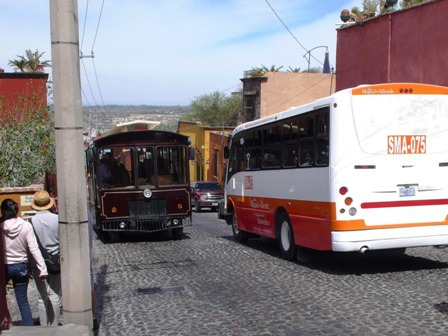
专访美国摄影家史提夫·麦凯瑞 战地摄影无比神圣
吴启基 (2009-06-25)

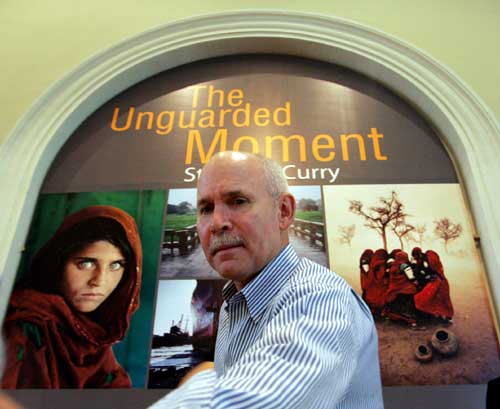
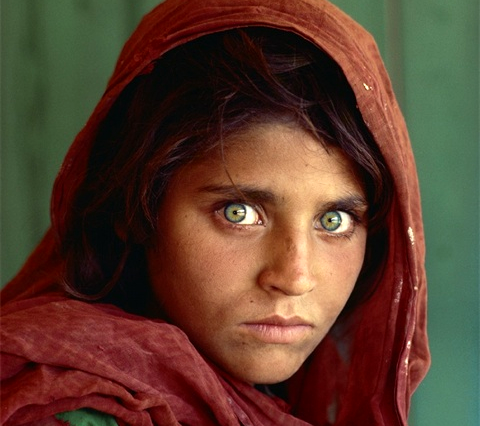

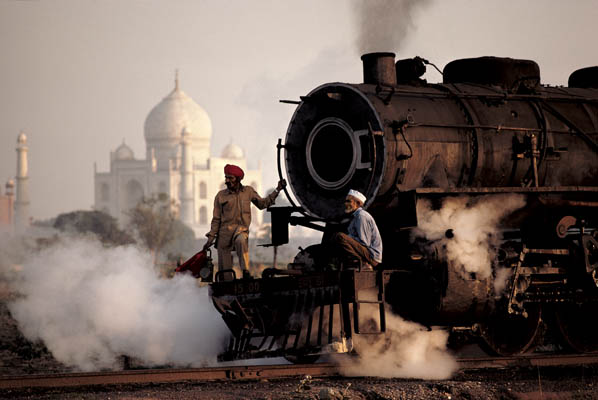






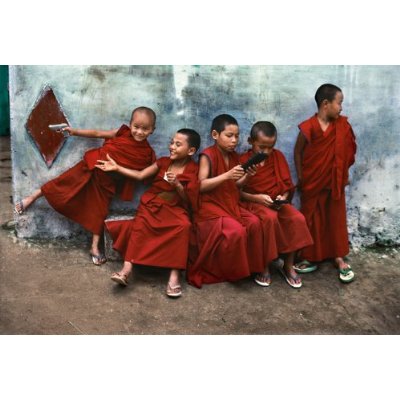
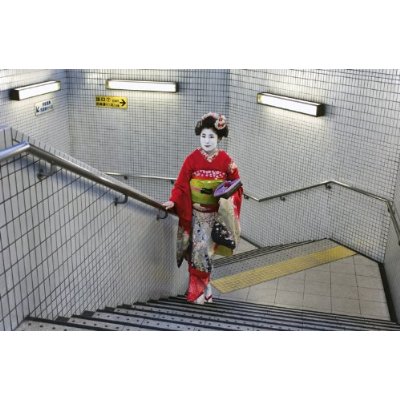
以拍摄战争新闻照片闻名于世的美国摄影家史提夫·麦凯瑞(Steve McCurry)为他的摄影展来新,接受本报访问时,谈到他工作的危险性。他说:“每一趟的拍摄任务都充满危险。但我总是在枪林弹雨中小心翼翼。有时我想自己是不是疯了,那个推动我前进、冒险的力量,是非常神秘的,好像是一种基因在作祟。人有意地把自己置身于威胁生命的境地中,在生与死之间,绝对是极端戏剧化。所以,也许是这种戏剧化的情境,让我感到无比刺激。”
问及在这么长久的采访工作任务中,作品有没有被哪个国家或政府查禁?他笑着说:“没有,至今还没有类似事件发生。可我在危险的阿富汗采访时,两次误入他们的限制区,结果被捉去坐牢:一次是一天,一次是五天。两次都是我孤军作战,没有任何人支援、搭救我。我只能说,到处有战争发生,像最近斯里兰卡政府清剿淡米尔之虎的军事行动,不是我就是其他同行,一定要有人到现场去看看和做报道。就这点来说,我们的工作,无比神圣 。”
他也说:“新闻工作者的任务,是把发生的事件详细报道出来。人们是通过广播、报纸、杂志、电视来了解世界各地发生的大事件。因此你必须很认真对待工作,不要让自己陷入任何不好的情绪中,以致干扰工作的进行,你必须锻炼这方面的能力才行。”
“阿富汗少女”至今让人震惊
史提夫·麦凯瑞也是国际新闻图片社马格南(Magnum)成员之一,这个地位崇高的组织,专门拍摄世界各个角落发生的战争和灾难。
http://www.stevemccurry.com/main.php
==========================================
http://en.wikipedia.org/wiki/Sharbat_Gula
Afghan Girl (photo)
Sharbat Gula (Pashto: شربت ګله, literally "Rose Sherbet") (Sharbat is pronounced [ˈʃaɾbat]) (born ca. 1972) is an Afghan woman of Pashtun ethnicity. She was forced to leave her home in Afghanistan during the Soviet war for a refugee camp in Pakistan where she was photographed by journalist Steve McCurry. The image brought her recognition when it was featured on the cover of the June 1985 issue of National Geographic Magazine, at a time when she was approximately 13 years old. Gula was known throughout the world simply as the Afghan Girl until she was formally identified in early 2002.

The picture of Sharbat Gula, as it appeared on the June, 1985 National Geographic cover.
Photo's subject
Gula was orphaned during the Soviet Union's bombing of Afghanistan and sent to the Nasir Bagh refugee camp in Pakistan in 1984. Her village was attacked by Soviet helicopter gunships sometime in the early 1980s. The Soviet strike killed her parents - forcing her, her siblings and grandmother to hike over the mountains to the Nasir Bagh refugee camp in Pakistan.[1]
She married Rahmat Gul in the late 1980s and returned to Afghanistan in 1992. Gula had three daughters: Robina, Zahida, and Alia. A fourth daughter died in infancy. Gula has expressed the hope that her girls will receive the education she was never able to complete.
1984 photograph
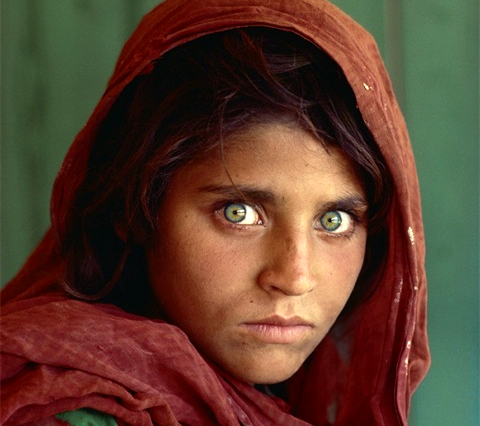
Steve McCurry's "Afghan Girl" original photo.
At the Nasir Bagh refugee camp in 1984, Gula's photograph was taken by National Geographic photographer Steve McCurry on Kodachrome color slide film. Gula was one of the students in an informal school within the refugee camp; McCurry, rarely given the opportunity to photograph Afghan women, seized the opportunity and captured her image. She was approximately 13 years old at the time.
Although her name was not known, her picture, titled "Afghan Girl", appeared on the June 1985 cover of National Geographic. The image of her face, with a red scarf draped loosely over her head and with her piercing sea-green eyes staring directly into the camera, became a symbol both of the 1980s Afghan conflict and of the refugee situation worldwide. The image itself was named "the most recognized photograph" in the history of the magazine.[2]
Search for the Afghan Girl
The identity of the Afghan Girl remained unknown for over 17 years; Afghanistan remained largely closed to Western media until after the removal of the Taliban government by foreign troops and local allies in 2001. Although McCurry made several attempts during the 1990s to locate her, he was unsuccessful.
In January 2002, a National Geographic team traveled to Afghanistan to locate the subject of the now-famous photograph. McCurry, upon learning that the Nasir Bagh refugee camp was soon to close, inquired of its remaining residents, one of whom knew Gula's brother and was able to send word to her hometown. However, there were a number of women who came forward and identified themselves erroneously as the famous Afghan Girl. In addition, after being shown the 1985 photo, a handful of young men questioned falsely claimed Gula as their wife.
The team finally located Gula, then around the age of 30, in a remote region of Afghanistan; she had returned to her native country from the refugee camp in 1992. Her identity was confirmed using biometric technology which matched her iris patterns to those of the photograph with almost full certainty. She vividly recalled being photographed—it was the first and only time she had ever had her picture taken. The fame and symbolic character of her portrait were completely unknown to her.
Modern pictures of her were featured as part of a cover story on her life in the April 2002 issue of National Geographic and was the subject of a television documentary, entitled Search for the Afghan Girl, which aired in March 2002. In recognition of her,[3] National Geographic set up the Afghan Girls Fund, a charitable organization with the goal of educating Afghan girls and young women.[4] In 2008, the scope of the fund was broadened to include boys and the name was changed to Afghan Children's Fund.[5]
====================================
# ^ Lucas, Dean. "Afghan Eyes Girl". http://www.famouspictures.org/mag/index.php?title=Afghan_Eyes_Girl. Retrieved on 2007-04-30.
# ^ "National Geographic: Afghan Girl, A Life Revealed". washingtonpost.com. The Washington Post Company. 2001-04-10. http://www.washingtonpost.com/wp-srv/liveonline/02/world/world_mccurry041002.htm. Retrieved on 2009-03-31.
# ^ Braun, David (7 March 2003). "How They Found National Geographic's 'Afghan Girl'". National Geographic Society. http://news.nationalgeographic.co.uk/news/2002/03/0311_020312_sharbat_2.html. Retrieved on 31 March 2009.
# ^ "National Geographic Society: Afghan Girls Fund". National Geographic Society. Archived from the original on 2004-12-06. http://web.archive.org/web/20041206042103/http://www.nationalgeographic.com/donate/afghan_girls_fund.html. Retrieved on 2009-03-15.
# ^ "National Geographic Society: Afghan Children's Fund". National Geographic Society. http://www.nationalgeographic.com/donate/afghan_childrens_fund.html. Retrieved on 2009-03-15.
===================================
http://cn.reuters.com/article/CNTechNews/idCNChina-4819720090623
In June 2009, McCurry was announced as the person to use the last roll of Kodachrome.
柯达Kodachrome彩色胶卷今年停产
2009年 6月 23日 星期二
路透纽约6月22日电---由于面临来自数码相机的激烈竞争,伊士曼柯达公司(EK.N: 行情)将停止生产Kodachrome彩色胶卷。
柯达公司表示,由于销量大幅下降,公司将于今年停止生产Kodachrome彩色胶卷,结束该胶卷 74年的历史。
公司胶卷、冲印及娱乐部总裁玛丽・简・海丽尔(Mary Jane Hellyar)说:“现在多数的摄影师都表示,他们倾向于用更新的技术--胶卷和数码--来捕捉影像。”
Kodachrome曾经是很多婴儿潮时期出生的人家庭幻灯片的首选胶卷。20世纪70年代中期,歌星保罗・西蒙曾在一首歌曲中唱道:“妈妈别拿走我的Kodachrome。”
http://www.youtube.com/watch?v=wZpaNJqF4po&feature=related
尽管Kodachrome胶卷十分耐用,可以捕捉到丰富、鲜明的色彩,但Kodachrome胶卷的生产过程却十分复杂。
同时,这一品牌还面临日本竞争对手富士(4901.T: 行情)的竞争压力。
柯达公司表示,在公司静态图片胶卷销售收入中,Kodachrome仅占不到1%。(完) |
    
Ld
Username: Ld
Registered: 01-2007
| | Posted on Tuesday, June 16, 2009 - 12:31 am: | |
http://news.bbc.co.uk/chinese/simp/hi/newsid_8010000/newsid_8016200/8016271.stm

经济寒流中感受日本樱花节
2009年04月24日
记者来鸿
罗兰·伯克
BBC记者
在日本,每年四月是樱花盛开的季节。樱花是日本文化的象征,一年一度的赏花节更是民众生活中不可缺少的重要活动。但是BBC记者罗兰?伯克发现,由于全球遭受二次大战以来最严重的经济危机,给观赏樱花的日本民众心里蒙上一层阴影:
这里的冬天时间很长、很冷、到处是灰蒙蒙的,而且很潮湿。再加上日本这个世界上第二大经济体的坏消息不断,更让人们有一种雪上加霜的感觉。
公众急切地期待着春天的到来,这就不足为奇了。
3月初,东京的樱花树的树枝上长出了红色花骨朵。
随后的几个星期里,就迎来了樱花盛开的季节 。
公园内道路两旁的樱花连成一片,彷佛是一团团粉色和白色的云朵。在河两边也是片片樱花,连绵不断。
樱花时节
在冬季,东京的河流不是很好看,因为河两边都是水泥建筑,沿河地段经常用来修建高速公路立交桥。
但是每年到了樱花时节,河两边无数怒放的樱花层层叠叠,树枝被压弯了腰,低垂在河面上。
此时此刻,东京的许多居民就会呼朋唤友或全家出动去观赏樱花。
在这座世界上人口最多的大都市里,似乎每一个人都在争先恐后去赏花。
上野公园是东京最大的公园,到处是人山人海,要想挤过去都有些困难。
公园内随处可以看到摄影爱好者,有的用手机拍下樱花的特写镜头,有的在樱花树下留住朋友的美姿。
日本人钟爱樱花,可以说到了无以复加的地步。
虽然每年秋季的红叶和插秧节都会庆祝一番,但是人们对樱花节却情有独钟。
在过去几百年,贵族们都要在樱花树下漫步或者席地而坐,赏花吟诗。
观赏樱花是日本"物哀"文化传统的一部分,这也许可以解释为樱花转瞬既逝的美丽在人们内心深处引发的一种悲喜交加的情感。
樱花时节到来之际,电视气象预报每天晚上结束时就会增加一项特别项目,根据温暖天气由南向北移动,随时向公众预报开花日期。
日本国内最早观赏樱花的时间是1月中旬,地点是位于南部气候温和的冲绳岛。
靖国神社
在东京,日本气象厅的官员密切观察靖国神社的樱花开放情况。
长期以来,靖国神社一直引起争议,因为在这里存放着接近250万名为日本战死者的灵位,其中包括在二次大战中的阵亡者。此外,靖国神社还供奉着一些战犯的牌位。
日军士兵经常被比喻为绚烂但生命短暂的樱花。许多士兵发誓阵亡后在靖国神社与战友重逢。
在靖国神社的许多樱花树中,有一颗树很有名气,树周围设有栅栏保护。
当这棵树上开出五六朵樱花时,东京的樱花季节就正式开始。紧随其后的是大规模的赏花会活动。
抢占地盘
我漫步穿过长野公园的时候,看到一群群穿着西服革履的公司职员盘腿席地而坐,一边品尝寿司、米饭、炒面和汤圆,一边喝着清酒和啤酒。
有一群赏花者热情邀请我加入他们的饮酒游戏。在众人的高声鼓励下,我们轮流饮下一杯杯度数较高的日本烧酒。
这次赏花会越来越热闹,一直持续到夜晚,樱花树上的灯笼也点亮了,更为大家增加了赏花的情趣。
每年在拥挤的公园里为公司聚会占地盘是一项很重要的任务,这种事情一般都是交给公司内最低级的职员去做。
日本许多公司每年也都是利用樱花季节开展招聘活动。
公司一般都要举行迎新会,一起唱公司歌曲,随后这些新职工就带着蓝色塑料布,被派出去为公司赏花会到公园里抢占最佳地盘。
每天一清早开始,这些穿着西服革履的新职员,很辛苦地把这些蓝色塑料布在抢占的地盘上铺开。
他们还用胶带把纸板盒粘在一起,做成一些小桌子。
就业困难
今年樱花盛开的时候,日本陷入战后最严重的经济危机。
许多制造厂家陷入困境,汽车和电子产品的出口减少了一半。日本曾经依靠这两大产业迅速发展成为工业技术大国。
随着利润的下降,日本企业的一些传统做法业也受到影响。
大公司的招工数量越来越少,年轻人希望获得终身就业的梦想很难实现。
尽管政府实行对公司点名批评的政策,但是一些公司仍然取消了他们的招工指标。
在上野公园里,新职工已经把地盘准备就绪,开始等候同事们晚上下班后来出席赏花会。不过他们还要等上很长时间,一些职工还带来睡袋,以便抵御早春的寒风。其中一位新职员深有感触地对我说:"现在能找到工作,我感到非常幸运。" |
    
Ld
Username: Ld
Registered: 01-2007
| | Posted on Friday, June 12, 2009 - 03:23 pm: | |
http://www.popyard.com/cgi-mod/newspage.cgi?num=344946&r=0&v=0
中国开建第二条进藏铁路 滇藏铁路丽香段开工
信源:《人民日报》海外版 |编辑:2009-06-12| 网址:http://www.popyard.org
八阕 http://www.popyard.org 来自藏、傈僳、纳西、白、彝等少数民族群众10日集聚在香格里拉建塘镇货运站站址,庆贺中国第二条进藏铁路----新建丽江至香格里拉铁路建设动员大会召开。从此,一条惠及23870平方公里的29个乡镇、37.3万人,其中少数民族人数占83.56%的钢铁大道将从这里延伸,连接上正在修建中的大丽铁路,进入西藏自治区。
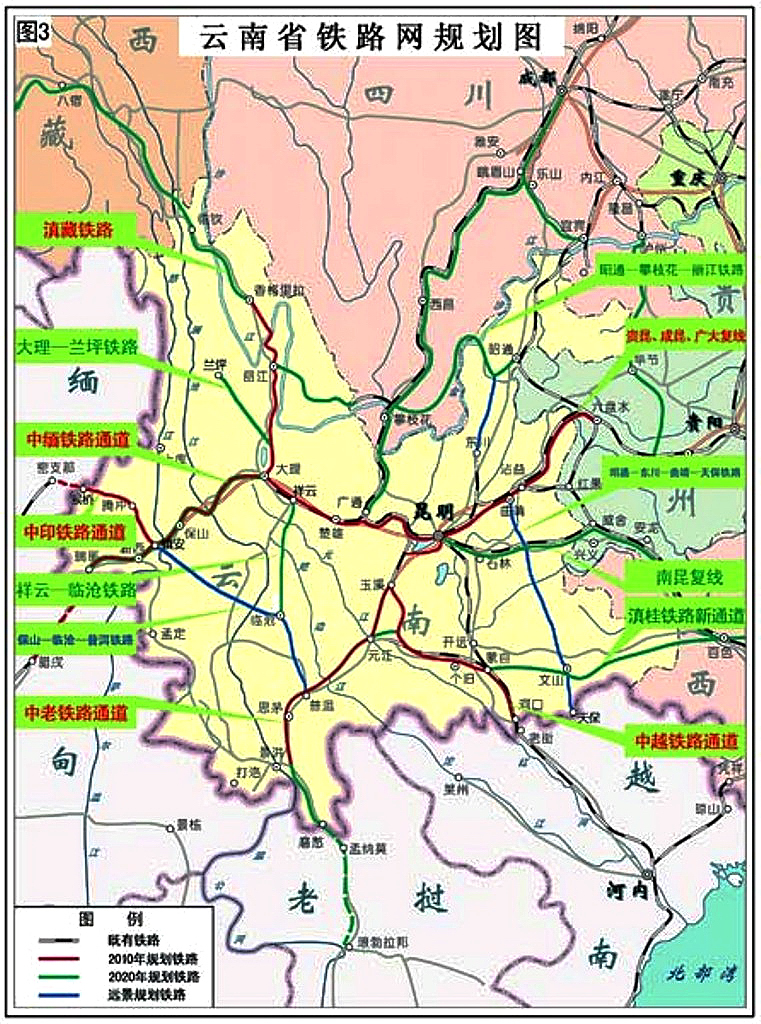
据了解,丽香铁路南起在建的大丽铁路丽江站,向北跨越金沙江,经小中甸至香格里拉,是我国中长期铁路网规划中“西部铁路网”及滇藏铁路的重要组成部分。丽香铁路穿越的地区既是云南省旅游、生物、矿产、水电资源最为丰富、最为独特的区域,也是我国藏族、纳西族、彝族、傈僳族、普米族、白族等少数民族聚居地。
云南省委常委、常务副省长罗正富在动员会上说,丽香铁路的建设,对于缓解滇西北地区交通运输状况,优化区域间资源配置,推动旅游、水电、矿产等资源的深度开发,维护藏区稳定,促进滇西北地区经济社会发展具有十分重要的意义。
加快云南铁路建设,是应对国际金融危机、扩大内需、拉动当前经济增长及促进云南长远发展的重要举措。云南省将以丽香铁路建设动员大会为新的契机,进一步掀起云南铁路建设新高潮,力争昆明枢纽扩能工程、昆玉铁路扩能工程、滇池东南环线、广大铁路扩能改造工程、云桂铁路、沪昆客运专线等项目年内开工建设,确保今年铁路建设投资完成80亿元、力争完成100亿元的目标。
按照国家发改委批复,丽江至香格里拉铁路线路由丽江站引出,经虎跳峡附近跨越金沙江,经小中甸至香格里拉,全长139公里。线路标准为国铁一级,全线采用电力牵引,客车设计时速120公里/小时。丽香铁路是规划研究建设的滇藏铁路的一段,可与大理、昆明等城市相通。丽江至香格里拉铁路建成后,从昆明至香格里拉的600多公里铁路线将全线贯通,完全可以实现夕发朝至。
该项目总投资92亿元,项目资本金为46亿元,占总投资的50%,其中,铁道部安排铁路建设基金32.2亿元,占资本金的70%,云南省基本建设预算内投资安排13.8亿元,占资本金的30%。其余46亿元利用银行贷款解决。项目建设工期为6年。 |
    
Ld
Username: Ld
Registered: 01-2007
| | Posted on Saturday, May 30, 2009 - 10:01 am: | |
长期以来,在摄影艺术世界里,人们的价值观都建立在欧美社会文化基础上。著名国际风光摄影大师李元教授认为,既然摄影艺术是一门无国界的“视觉语言”,因此有必要深入探讨摄影创作,如何表现摄影者个人的文化背景。
李元将在6月6日举办的“廉凤讲座”上,分享他对这个课题的长期思考。讲座上,他将重点论述摄影艺术的特性,作为中国传统文化主流的山水艺术,以及他本人如何利用摄影这门艺术形式,表述和发挥中国文化的哲学和宇宙观。
今年73岁的李元拍了近40年的照片,自称自己的创作“不中不西”,也可以说“又中又西”,在中西文化的夹缝中,寻求创意的表现。(龙国雄摄)

http://www.zaobao.com/special/face2face/pages1/face2face090530.shtml
第三只眼睛寄情山水间 访世界风光摄影大师李元教授
徐伏钢 (2009-05-30)
多年来,李元的风光摄影作品以其特有的文化内涵和独特的艺术视角,风靡全球。李元本人被美国权威摄影出版机构列为“近代八大风光摄影大师”之一,八位摄影大师中,只有李元一人是华裔摄影家。
说起风光摄影,无论是在西方还是东方,李元都有很多专业的和业余的“粉丝”。但是,也许说来有些令人难以置信,在摄影这个艺术殿堂里,李元其实算不得“科班”出身。他在美国念的是物理,后来当了大学物理学教授。是怎样的机缘,让他端起相机,一步步走进摄影这个彩色世界的呢?
“说起来,那是在1969年的夏天,我来到美国以后九年来的第一次长假。”李元回忆说。他和朋友一起开车横贯美洲大陆,来一次名副其实的“逍遥游”。正是这次一个多月的旅游,让他第一次真正走进了大自然,感受到它的吸引力和号召力。
“就是在那个时候,一种‘情景相融’的潜意识在我心头涌现。我想到中学读过的王粲《登楼赋》,和他那份‘虽信美而非吾土兮’的感叹,也感到几分杜甫‘飘飘何所似,天地一沙鸥’的茫然。我在隐隐约约之中意识到,景和情之间有一种难以形容的关联。”
他说:“我当时就想把看到的景色拍下来,那份拍摄照片的激情,似乎只有用冲动和发泄来形容!”
度假回去后,他决定自己买一台单反相机。拿上相机,他突然发现即使四周过去熟悉甚至不太注意的环境,也突然充满了拍摄的激情。
那年秋天,他第一次领悟到秋天的色彩竟是如此丰富。自此,他通过照相机的“第三只眼睛”,开始领悟到“以影求知”的乐趣。
李元说:“摄影把我带进了大自然的环境。走到野外,我感到一份亲切和沟通,但是真正要把我的感受通过照片来表达,却是一份挑战。”从那时起,他开始认真拜师学习摄影,由此走上了一条艺术创作的不归之路。

摄于西藏阿里:一朵庞大的浮云,像是悬挂在天际的实体,既带有几分冉冉上升的飘欲,也让人感到实质的凝重。相对之下,耸立的雪峰反倒显得渺小而单薄。
风光摄影更多像散文
相机对于摄影家来说,正如书法家手中的笔。作为一门艺术形式,摄影自有它的表现特质,不能简单地等同于“咔嚓”一声拍照片。李元把摄影的艺术表现特质,归纳为:客观性、瞬间性和发现性。
他说,摄影和绘画在创作的基础上,是两种完全不同的追求,前者建立在“实物成像”基础上,所以其画面必须建立在快门开启的一段时间里。换句话说,建立在“实物成像”基础上的摄影,在创意和构思的程序上,同绘画,甚至于音乐、雕刻和文学等其他创意的媒体来比较,是有所差异的。
李元认为,摄影是一门特有的“视觉语言”,它能把一份客观的事实通过相机变成主观意识的观察和流露,并表现在照片上。如果说文章可以表现出人类的智慧和感情,那么今天的摄影艺术也具有同等的效应。
“风光摄影所带来的更多像是一篇散文,它所表露的是摄影者触景生情的一份感觉,表现出大自然对摄影者所带来的启发,从而流露出摄影者对于在他四围大自然环境的认识和感受。”
随时领会老天爷让我们拍什么

摄于西藏阿里:在广阔的西藏高原,经幡象征着人的存在。它们翻飞的形象,几乎像是欢欣雀跃的孩童,和朝霞一起共同迎接新的一天来临。
由于风光摄影的瞬间性建立在天候和光影效果上,因而很多风光摄影爱好者会起早落夜,去等候朝日和夕阳所能带来的效果。李元则认为,其实天候和光影效果难以预料,这种“靠运气”的被动感,局限了摄影者的选择。在他看来,全天候摄影依然是可行的。
他说,photography(摄影)这个词,是由photo(光线)和graphic(描绘)组合起来的,说明摄影是一门有关景物和光影,以及气候条件之间配合的艺术。
“我们无法左右气候和光线,所以有必要像美国谚语所说:‘假如我们无法战胜它,那么我们就和它合伙来干’。
“我们不妨把天候和光影效果作为主要对象,而去找寻当时环境下可以和它配合的题材和景物。所以,问题不是我们想拍什么,更重要的是,要随时领会到老天爷让我们拍摄什么。”
艺术的价值在于它的创造性和原创性。李元说,风光摄影已经不再是静态景物的纪录,一桩瞬间即逝的情况就发生在眼前,它的捕捉不是在于记录一个突然发生的故事,而是一幅通过构图所带来有意义(也有感觉)的画面。
“我从来就不认为风光照片的拍摄仅限于纯粹的纪录,也不从单纯的‘美感’或者其他绘画里面的一些意念,来决定我的拍摄。即使在我学习摄影的阶段,用‘风景明信片’或是‘挂历照’来形容一张风光摄影照片,在我看来,都是一种含蓄的贬意。”
李元认为,用“见山是山,见山不是山,见山又是山”,来解释风光摄影所带来的挑战,可能最为确切。
风光摄影的挑战:见山是山 见山不是山 见山又是山
摄影艺术对中国传统文化的传承和发挥

摄于美国新泽西州:一般来说,晨雾带来的是一份轻逸而又神秘的气氛。但在阳光和丛林的阴影带来的节奏下,却带来了充满活力的动态,让我们从中体悟到了天地交汇的理念。
李元谈起,虽然自己对中国文化里情景交汇的传统,在中学时代学读诗赋的时候已经有所接触,对《归去来兮辞》中陶渊明在一片景色面前“抚孤松而盘桓”的那份心情也有些理解,但风光摄影和中国文化之间深厚的联系,他却是在80年代以后才逐渐认识到的。
李元从小在中国社会里成长,深受中国传统文化的潜移默化影响,而司马迁的一句“究天人之际,通古今之变,成一家之言”,更为他带来启发。从此,找寻中国文化和风光摄影之间的关联,成了他有意识的追求。
李元说,山水画在中国艺术传统上的重要地位充分表明,题材的局限并不能束缚艺术家的发挥。因为画面里素材本身形象的处理,和不同素材之间的配合,是无穷无尽的。“这个情形就像中药里的配伍一样,每一味药都有它本身的功效,放在一起却产生难以预料的结果。”
从有限的选择来反映人类广泛的智慧,本来就是艺术的精华所在。李元说,就像《易经》八卦的组合可以产生无穷的解释与引申,风光摄影的极致就应该追求相似的发挥。
西方摄影界难追求“天人合一”思想
不仅如此,李元认为中国艺术里“天人合一”的哲学思想,所带来对大自然描绘的人格化,是西方摄影界很难理解和追求的。在“天人合一”的中国传统文化里,人类常被认为是宇宙的一部分而不是宇宙的主宰者,而大自然却像人一样充满着生机与活力。
唐代诗人王维对于大自然的景色曾作过这样的描绘:“江流天地外,山色有无中,郡邑浮前浦,波澜动远空。”李元说,王维不仅给这片景色增添了蓬勃生气,表达了他的内心激荡,流露出一种由永恒博大的风光所唤起的感情,而且字里行间,也让我们看到一种超脱飘逸的意境与情趣。
另一方面,“仁者乐山,智者乐水”的思想,更进一步把我们对大自然的体会,直接连接到人性的陶冶,把风光看作丰富精神生活,增进自我修养的源泉。这种“取欢仁智乐,寄畅山水阴。清冷涧下濑,历落松竹林”(王羲之语)的认识,使得大自然环境能起到教诲者的作用,也能成为艺术和文学追求者的自我引申。
大半生生活在西方社会的李元,深有感触地说,要把中国文化传统和摄影结合在一起,就要利用摄影特性,来探讨民族文化新的表现手法,而不是只限于烟云缭绕、层峦叠嶂的画面。应当在西方对于摄影特性所得到的经验上,赋予中国文化传统里对于大自然独特的认识和深度。
李元说:“风光山水诗文是我们华族文化和艺术传统的基础。如果我们不去做这个尝试,没有别人会做同样的努力。”
李元自称是“候鸟”
今年73岁的李元自称是一只“候鸟”,春秋时节在中国,冬夏两季在美国。无论他走到哪里,都放不下手中的相机。对他来说,摄影已成为他生命的重要组成部分,他甘愿终生痴迷其中。
他说,自己的创作“不中不西”,也可以说“又中又西”,永远是在中西文化的两道夹缝中,寻求自己的创意表现。
“什么是艺术创作?艺术创作就是一种叛逆行为。”表面看上去温文儒雅的李元,最终露出了他骨子里的那股反抗性。
李元简介
李元原籍中国浙江宁波,1958年毕业于台湾大学,1966年获得美国印第安纳大学哲学博士。目前,他是美国新泽西州立罗特格斯大学荣誉退休教授,任世界华人摄影学会副会长。
李元分别在美国和中国出版有十余本摄影书籍。1984年,他的摄影作品被列入美国摄影出版社的《风光摄影——八位当代大师的艺术与技术》。这些年来,他的摄影作品和摄影论文经常在美国、中国、新加坡、日本、马来西亚、香港和台湾等地的摄影刊物中登载。
目前,他为中国新华社的《摄影世界》月刊撰写专栏。近期内,他的最新摄影著作《风光摄影的创意与实践》将由中国摄影出版社出版发行。
《联合早报》
(编辑:苏亚华) |
    
Ld
Username: Ld
Registered: 01-2007
| | Posted on Thursday, May 21, 2009 - 12:05 pm: | |
Even when you finally see the summit flags ahead, that walk seems never-ending
How to climb Mount Everest
http://news.bbc.co.uk/2/hi/uk_news/8060673.stm
By Andrew North
BBC News, Everest Base Camp
===============================
Five stages to Everest summit
http://news.bbc.co.uk/1/hi/world/south_asia/8060757.stm
Veteran British adventurer Sir Ranulph Fiennes has reached the summit of Mount Everest, succeeding after two previous attempts ended in failure.
Computer graphics shows the final stages in the climb to the summit of Mount Everest.
The BBC's Andrew North describes his journey to Everest Base Camp
To have a chance of standing for just a few minutes on the highest point on earth takes an expedition of at least two months.
Sir Ranulph Fiennes has been at Everest base camp since early April.
Climbers need this time to allow their bodies to acclimatise to the thin, oxygen-depleted air, so they can survive the so-called "Death Zone" above 8,000m (26,240 feet).
Everyone has to take the same approach - ascend too fast and you can die from altitude sickness.
But "getting to the top is 90% mental", says British guide and six times Everest summiteer Kenton Cool, who has been with Fiennes on the mountain again this year.
Most expeditions to the Nepalese side of Everest happen in April and May, when the weather is usually at its most settled.
For those two months, hundreds of people descend on a patch of the Khumbu glacier beneath the mountain, transforming it into a multi-coloured tent city which is Everest base camp.
Altitude sickness
The global recession has had its affect here too though - regulars say the camp is smaller this year, with many climbers having pulled out because of the cost.
They start by flying into a tiny airstrip on the edge of the Himalayas at Lukla, followed by a 10-day hike to base camp, beginning the acclimatisation process.
Even at base camp, at 5,300m, it can be tough coping with the thinner air. Many people develop headaches and painful hacking coughs. They can find it harder to sleep and eat.
Meanwhile, specialist climbing Sherpas - from the Everest region - have already begun preparing the route, fixing ladder bridges across crevasses on the first section through the treacherous Khumbu glacier or icefall.
They are known as the "ice doctors" and they re-check and repair the route every day in case of avalanches or movements on the glacier. Most expeditions depend on Sherpa support.
Further up, they fix safety ropes on the more difficult sections of the mountain.
It is often six weeks or more after arriving at base camp before climbers actually go for the summit.
They spend that time making a series of incremental ascents to get used to the thin air, using a "climb high, sleep low" approach - progressively going higher but then descending again to rest.
Route plan
The route up is like this: first, climbers have to negotiate the crevasses and ice walls of the Khumbu icefall.
On their final summit push, they usually bypass Camp 1 and go straight to Camp 2 or Advanced Base Camp at about 6,400m, bypassing Camp 1.
Next day, there is a steep climb up the face of the neighbouring peak of Lhotse. Spiked steel crampons are essential on the sometimes rock-hard ice.
They stay the night at Camp 3 about halfway up the face before tackling the rockier sections of the Yellow Band and then the Geneva Spur.
This leads to Everest's southern shoulder, the South Col, and Camp 4 at just under 8,000 metres. This is the launching point for the summit almost a kilometre above.
Climbers are now in the "Death Zone", so-named because there's so little oxygen in the air that nothing - plant or animal - can live up there for long.
Scarce oxygen
Using bottled oxygen helps, but does not cancel out the effects of being that high.
The body is literally starting to break down, using up its stores. So it is a race against time.
On the summit, there is less than a third of the amount of oxygen available as at sea level.
Typically, climbers start out for the summit late at night, aiming to be on top the following morning with enough time to get all the way back to the South Col in daylight.
For this reason, team leaders impose turnaround times. If their climbers are not close enough to the summit by that time - often about 1pm - they have to descend.
It does not always work out like that. So near, people keep on going but then don't have the energy to get down again.
Experienced mountaineers will often say that Everest is not technically difficult to climb by the South Col route, compared with other Himalayan peaks.
But at this altitude, battling with hypoxia or oxygen starvation, each step is a decision.
'The longest walk'
The thin air plays with your mind. Many die here because they are not able to think straight.
Sometimes the only landmark ahead is the corpse of a dead climber.
There is one last obstacle before the top - a rocky outcrop called the Hillary Step, named after Sir Edmund Hillary, the first man to climb Everest with Sherpa Tenzing Norgay.
After that, the summit is about 30 or 40 minutes away, up an undulating snow slope. But "it's the longest walk in the world," says guide Kenton Cool. "Even when you finally see the summit flags ahead, that walk seems never-ending."
Then it is all the way down again, many climbers sleeping a night at the South Col before returning to base camp next day.
EVEREST FACTS AND FIGURES
Height: 8,848 - 8,850m (29,029 - 29,035 feet)
First ascent: 29 May, 1953, Edmund Hillary/Tenzing Norgay
Number of ascents up to 1988: less than 200
Number of ascents up to end of 2008 climbing season: 4,109 by 2,700 individuals
Most people on the summit in a single day: 116, on 22 May, 2003
Oldest summiteer: 76-year-old Nepalese man, Min Bahadur Sherchan |
    
Ld
Username: Ld
Registered: 01-2007
| | Posted on Monday, May 18, 2009 - 10:42 am: | |
Sensor Size
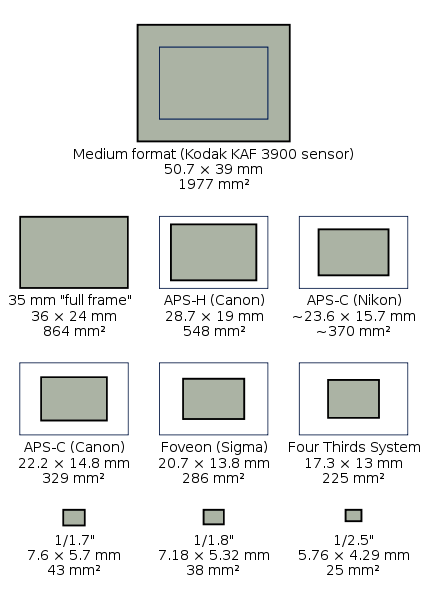 |
    
Ld
Username: Ld
Registered: 01-2007
| | Posted on Friday, May 15, 2009 - 01:48 pm: | |
Fujifilm Finepix F100fd 12MP Digital Camera with 5x Wide Angle Dual Image Stabilized Optical Zoom

By Doctor.Generosity (Western MA United States) - See all my reviews
I bought this because I hoped it would be an upgrade from my favorite digital camera, the Fujifilm F30. Unfortunately, it is not better overall.
The F30, which is out of production, developed something of a cult following in techno-nurd circles because it had the incredible sensitivity of ISO 3200 with low noise (speckle). Fuji accomplished this with their "Super CCD" using hexagonally packed, larger sensors for greater fill factor and the ability to capture lower light intensities. (CCD photodiodes typically operate pretty close to the quantum limit of efficiency, so there is no possible improvement except by larger pixels.) The technology was brilliant but worked well only up to about 6 megapixels for the small chip size used in pocket cameras. Unfortunately Fuji's marketing people were not as imaginative as their semiconductor team and did not know how to persuade the buying public that dim light image quality is more valuable to the average photographer than pixel count - which it is. Caving in to the pixel race, later Fuji F cameras had more but smaller pixels, giving up the extreme low noise, low light capabilities. As a result used F30's sell at high prices on eBay.
Now comes the F100, which Fuji advertises as the pocket camera to end all pocket cameras, state of the art in every way, and which is supposed to extend the low light theme to 12MP, offering ISO 3200 for full resolution and up to an astounding ISO 12,800 with pixels reduced to 3MP.
So, how does it work? I've just spent the better part of a spring day comparing the F100 images directly with my F30 under various conditions.
Unfortunately, no, they did not manage to repeal the laws of physics. At ISO 3200, the 12MP F100 with its necessarily smaller pixels gives rougher images than my 6MP F30. And as for the ISO 12,800; forget it, it's a gimmick. The images are so rough as to be useless. This irritated me; borders on deceptive advertising.
The higher pixel count does stand up better to higher magnification or cropping. In good light where it is possible to use ISO 200, the F100 gives wonderful photos which can be cropped or blown up significantly more. But for the unique higher ISO range for which people look to Fuji, the F100 is actually a bit worse in image quality. Disappointing.
Otherwise, the F100 gives the impression of a pile of disconnected features There are worthwhile features in the F100 over the F30; one is the wide angle lens, the equivalent of 28mm, uncommon on pocket cameras; another is active image stabilization which allows slower shutters. Also F100 accepts SD memory cards whereas the F30 only took oddball proprietary xD's. In my tests however, the benefit of the Wide Dynamic Range feature seemed hard to discern. The battery seems to discharge pretty quickly. The nice aluminum case of the F30 has been replaced with Chinese plastic. (By the way, I read about a "pink banding" problem with the F100 but did not observe this.)
Otherwise, some of the annoyances of the F30 remain; a strange USB connector which won't work with your non-Fuji cables. The movie mode, for me one of the really cool features of a pocket camera, has not been improved at all; it is still not possible to zoom the lens while capturing a movie. The zoom itself is too hard to control, always overshooting one way or another - Hey guys, what would be wrong with a simple manual ring to zoom the lens?
Most Japanese cameras and all Fujifilm cameras including this one are marred by byzantine, obscure, hard to remember menu systems, packed with a plethora of "scene modes" certain to be ignored by the type of user who would buy an advanced digicam in the first place. They serve no purpose except to clutter things up. The other day in a store I saw a digicam that boasted of "Fifty Scene Modes!" Fifty?? Hey folks, what happened to the idea of a POINT AND SHOOT camera??
Overall, I admire Fujifilm which is one of the world's premier imaging technology companies. But as with many large corporations, its products are designed by uneven committees; brilliant CCD people, me-too market people, and an interface team who muck things up based on false assumptions. Companies which produce really great products, like Apple, do so because one person with excellent design sense governs the whole development.
Bottom line: I was disappointed because the F100 was not a clear advance over my two year old F30. It does have a nice wide angle lens, and if you don't mind the high price you may love it. In good light the photos are superb. But overall it does not give the sense of a well integrated product. Once the dim light capabilities are compromised, the F100 is just another camera which competes with many others. |
    
Ld
Username: Ld
Registered: 01-2007
| | Posted on Wednesday, May 13, 2009 - 06:47 pm: | |
Before we continue the tour, I want to briefly mention the S100fs' sensor, and why it's different than what you'll find on most fixed-lens cameras. First off, the sensor is physically larger than your typical compact camera CCD. At 2/3" in size, its area is twice that of the sensors found on most ultra-zoom cameras (such as the Panasonic Lumix DMC-FZ18). It's not quite digital SLR sized, but it's a lot closer than the competition.
The second unique thing about the S100fs' sensor is its design. It uses an 8th-generation SuperCCD HR sensor, which has a unique hexagonal photosite layout. The design of the SuperCCD sensor captures more light than conventional CCDs, allowing for improved resolution and sensitivity.
Returning to our tour of the front of the FinePix S100fs, the next item of note is the pop-up flash, which is released manually. The flash is quite powerful, with a working range of 0.6 - 7.2 m at wide-angle, and 2.5 - 3.8 m at telephoto (both at Auto ISO [max 800]). Should you need more flash power and less chance of redeye, you can attach an external flash either via a hot shoe, or a flash sync port (which is located just to the left of the lens).

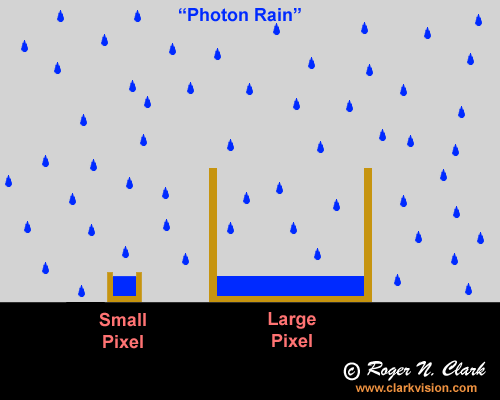
http://www.clarkvision.com/
@Scaramanga: Unfortunately this isn't a DSLR but an ultra zoom EVF consumer cam.
Nice touch lowering the MP count, but it's unfortunate that the CCD is still the size of my pinky fingernail.
see 'sensor sizes' at www.dpreview.com
1:58 AM on Thu Jan 24 2008
Dr:
No. Imagine all cameras have a sensor which is a fixed size. Say, the size of a 35mm negative.
If you use a sensor with fewer pixels, then each pixel on that sensor will be bigger. So more light will hit it. The more light that hits a pixel, the darker the conditions you can take a photo in, and the less noise the image has.
You can also increase the amount of light hitting the sensor with a bigger lens. That's why the cameras on cellphones suck in low light conditions. The lens is too tiny to collect much light AND the sensor is tiny, so either it's low res, or the pixels are small.
There's just one thing I don't get. If I take a sensor of the same size, and quadruple the number of pixels on it, I'm still collecting the same amount of light... but now it's distributed amongst four pixels. When I have plenty of light the extra resolution is nice. But when I have low light... Couldn't I get the same quality image just by scaling the image down by half on each axis? Averaging the result of the four pixels should give roughly the same result as using one big pixel, but has the disadvantage that I don't get to have the option of higher resolution when taking photos in sunny conditions.
Unless maybe between the pixels there's space that is wasted and by making bigger pixels there's less waste? But how much waste could there be? 5%?
http://zhidao.baidu.com/question/3271987.html
感光器件工作原理
作为手机新型的拍摄功能,内置的数码相机功能与我们平时所见到的低端的(10万--130万像素)数码相机相同。与传统相机相比,传统相机使用"胶卷"作为其记录信息的载体,而数码相机的"胶卷"就是其成像感光器件,而且是与相机一体的,是数码相机的心脏。感光器是数码相机的核心,也是最关键的技术。
目前数码相机的核心成像部件有两种:一种是广泛使用的CCD(电荷藕合)元件;另一种是CMOS(互补金属氧化物导体)器件。由于手机中的拍照功能是新兴起的,所以目前用于手机中数码相机的感光元件基本上都是CMOS的。
电荷藕合器件图像传感器CCD(Charge Coupled Device),它使用一种高感光度的半导体材料制成,能把光线转变成电荷,通过模数转换器芯片转换成数字信号,数字信号经过压缩以后由相机内部的闪速存储器或内置硬盘卡保存,因而可以轻而易举地把数据传输给计算机,并借助于计算机的处理手段,根据需要和想像来修改图像。CCD由许多感光单位组成,通常以百万像素为单位。当CCD表面受到光线照射时,每个感光单位会将电荷反映在组件上,所有的感光单位所产生的信号加在一起,就构成了一幅完整的画面。
CCD和传统底片相比,CCD 更接近于人眼对视觉的工作方式。只不过,人眼的视网膜是由负责光强度感应的杆细胞和色彩感应的锥细胞,分工合作组成视觉感应。 CCD经过长达35年的发展,大致的形状和运作方式都已经定型。CCD 的组成主要是由一个类似马赛克的网格、聚光镜片以及垫于最底下的电子线路矩阵所组成。目前有能力生产 CCD 的公司分别为:SONY、Philps、Kodak、Matsushita、Fuji和Sharp,大半是日本厂商。
互补性氧化金属半导体CMOS(Complementary Metal-Oxide Semiconductor)和CCD一样同为在数码相机中可记录光线变化的半导体。CMOS的制造技术和一般计算机芯片没什么差别,主要是利用硅和锗这两种元素所做成的半导体,使其在CMOS上共存着带N(带–电) 和 P(带+电)级的半导体,这两个互补效应所产生的电流即可被处理芯片纪录和解读成影像。然而,CMOS的缺点就是太容易出现杂点, 这主要是因为早期的设计使CMOS在处理快速变化的影像时,由于电流变化过于频繁而会产生过热的现象。
两种元件不同之处
由两种感光器件的工作原理可以看出,CCD的优势在于成像质量好,但是由于制造工艺复杂,只有少数的厂商能够掌握,所以导致制造成本居高不下,特别是大型 CCD,价格非常高昂。同时,这几年来,CCD从30万像素开始,一直发展到现在的600万,像素的提高已经到了一个极限。
在相同分辨率下,CMOS价格比CCD便宜,但是CMOS器件产生的图像质量相比CCD来说要低一些。到目前为止,市面上绝大多数的消费级别以及高端数码相机都使用CCD作为感应器;CMOS感应器则作为低端产品应用于一些摄像头上,若有哪家摄像头厂商生产的摄想头使用CCD感应器,厂商一定会不遗余力地以其作为卖点大肆宣传,甚至冠以"数码相机"之名。一时间,是否具有CCD感应器变成了人们判断数码相机档次的标准之一。
CMOS影像传感器的优点之一是电源消耗量比CCD低,CCD为提供优异的影像品质,付出代价即是较高的电源消耗量,为使电荷传输顺畅,噪声降低,需由高压差改善传输效果。但CMOS影像传感器将每一画素的电荷转换成电压,读取前便将其放大,利用3.3V的电源即可驱动,电源消耗量比CCD低。CMOS影像传感器的另一优点,是与周边电路的整合性高,可将ADC与讯号处理器整合在一起,使体积大幅缩小,例如,CMOS影像传感器只需一组电源,CCD却需三或四组电源,由于ADC与讯号处理器的制程与CCD不同,要缩小CCD套件的体积很困难。但目前CMOS影像传感器首要解决的问题就是降低噪声的产生,未来CMOS影像传感器是否可以改变长久以来被CCD压抑的宿命,往后技术的发展是重要关键。
影像感光器件因素
对于数码相机来说,影像感光器件成像的因素主要有两个方面:一是感光器件的面积;二是感光器件的色彩深度。
感光器件面积越大,成像较大,相同条件下,能记录更多的图像细节,各像素间的干扰也小,成像质量越好。但随着数码相机向时尚小巧化的方向发展,感光器件的面积也只能是越来越小。
除了面积之外,感光器件还有一个重要指标,就是色彩深度,也就是色彩位,就是用多少位的二进制数字来记录三种原色。非专业型数码相机的感光器件一般是24 位的,高档点的采样时是30位,而记录时仍然是24位,专业型数码相机的成像器件至少是36位的,据说已经有了48位的CCD。对于24位的器件而言,感光单元能记录的光亮度值最多有2^8=256级,每一种原色用一个8位的二进制数字来表示,最多能记录的色彩是256x256x256约16,77万种。对于36位的器件而言,感光单元能记录的光亮度值最多有2^12=4096级,每一种原色用一个12位的二进制数字来表示,最多能记录的色彩是 4096x4096x4096约68.7亿种。举例来说,如果某一被摄体,最亮部位的亮度是最暗部位亮度的400倍,用使用24位感光器件的数码相机来拍摄的话,如果按低光部位曝光,则凡是亮度高于256备的部位,均曝光过度,层次损失,形成亮斑,如果按高光部位来曝光,则某一亮度以下的部位全部曝光不足,如果用使用了36位感光器件的专业数码相机,就不会有这样的问题。
http://www.dpreview.com/learn/?/Guides/dslr_buying_guide_01.htm
Why a digital SLR?
So you've decided to invest in a new digital camera and have made your mind up that you want to step up to a digital SLR, but the huge range of models on offer and endless flow of technical jargon have left you more confused than when you started? Fear not, this page will take the pain out of choosing the perfect digital SLR for you, whether you're a seasoned shooter or a total novice.
Before we get down to business it's worth stopping for a moment to ask the question: why would anyone want a digital SLR when compact digital cameras are so much smaller, lighter and more affordable? The answer can be summed up in two words: versatility and image quality.
The versatility isn't just the fact you can change lenses and add a wide range of accessories - from basics such as flashguns and remote controls to the more specialized equipment that allow SLRs to capture anything from the tiniest bug to the most distant stars. It's also about the creative versatility offered by the more advanced controls and higher quality components.
And this leads on to the second factor; image quality. In broad daylight the quality difference between a good compact and a digital SLR is minimal; both will produce sharp, colorful results with little effort. But when you start to push the boundaries a bit more; shooting in low light, attempting to capture fast moving sports action or wildlife, or when you want to experiment with shallow depth of field (to add a soft background to a portrait for example), the advantage of a digital SLR's larger sensor and higher sensitivity start to make a big difference. A digital SLR can't beat a compact camera for 'pop it in the purse or pocket' convenience but for serious photography the SLR wins hands down. With prices lower than ever it's not that surprising to discover that many people own one of each.
What do you need?
With so many digital SLRs on the market at so many different price points it's a good idea to narrow down your options by thinking about what 's important to you, and what you want to do with the camera. Do you want the same kind of 'point and shoot' simplicity as you get with a compact camera or are you the type of photographer who likes to roll up his or her sleeves and take control of every function? Many entry-level DSLRs offer a range of 'point and shoot' subject / scene modes, whereas more 'professional' models don't (though all have a basic 'auto' program mode). Do you shoot a lot of sport or wildlife? If so you'll need a fast camera with a high frame rate, and will probably want one of the smaller sensor formats.
If you shoot in very low light you'll be looking for a camera with the best possible high ISO performance and possibly in-body image stabilization, if you do a lot of studio, portrait or macro work you may well decide that a 'live view' function is a high priority.
Finally there are practical considerations; do you need a particularly rugged (or weatherproof) body? Does the size and weight of the camera play an important role in your choice? Do you have a particular application in mind that requires a specialist lens or other accessory? Not all camera systems offer the same range of lenses and not all cameras are compatible with the more specialized add-ons. And don't forget that most DSLRs are compatible with many of the lenses and accessories originally designed for film SLR cameras (from the same manufacturer), so if you're already heavily invested in a film system you may want to stick to the same system when you move to digital.
Armed with some answers to these questions you can use the information on the rest of this page to produce a shortlist of cameras that match your needs perfectly.
Sensor size
Let's look first at the physical size of CCD or CMOS sensor used to capture your photographs. Although there are slight variations, virtually all DSLR sensors fit into one of three size categories (starting with the largest); Full Frame, APS-C and Four-Thirds. Sensor size isn't as important as some people would have you think, but there are some key differences. The first is what is known as the 'crop factor'. As the diagram below shows, as the sensor gets smaller it captures a smaller area of the scene, resulting in a photograph that looks like it was taken at a longer focal length (1.5x or 1.6x longer for APS-C, 2x for Four-Thirds).
The crop factor isn't a major issue for most users, but it does have important consequences for some. If you're buying a digital SLR to replace a film model because you've got a kit bag full of lenses you need to be aware that unless you buy a full frame model all your lenses will produce very different results on your new camera.
For telephoto shooters the result is quite a bonus, as all your lenses will effectively get even more powerful. On the other hand the crop factor means your wideangle lenses will no longer offer anything like a 'wide' field of view. Fortunately there is a wide range of specially designed 'digital only' lenses for smaller sensor DSLRs.
The three most common sensor sizes compared: full frame, APS-C and Four-thirds. Smaller sensors 'crop' the scene and make a lens appear to have a longer focal length. For sports and wildlife shooters the smaller sensor has the effect of making their telephoto lenses and zooms even more powerful.
So which is right for you? Each has its own benefits and each has its limitations, and if you're building a DSLR system from scratch you needn't get too hung up on which is right for you.
The largest (and most expensive) DLSR format is full frame (so called because the sensor is the same size as a frame of 35mm film). DSLRs with full frame sensors have the biggest, brightest viewfinders and because there's no crop factor are often chosen by photographers who are upgrading from a film SLR and already own expensive wideangle lenses. The larger sensor also means that - all other things being equal - full frame cameras will produce the best results in very low light and at higher sensitivities. On the downside, full frame cameras are big and expensive, and there is only a handful of models to choose from. You also lose the focal length 'boost' offered by smaller sensor cameras when shooting with telephotos.
APS-C is by far the most common format, used in virtually all Canon, Nikon, Pentax and Sony DLSR models. With a crop factor of 1.5x or 1.6x you need special digital lenses to get true wideangle results, but these are readily available and are usually less expensive than their 'full frame' counterparts. The 'kit lens' supplied with most APS-C cameras is a good starting point, offering a versatile zoom range from wideangle to short telephoto.
The difference in size and weight between a full frame professional level camera (Nikon D3, left) and a compact entry-level DSLR (Nikon D60, right) is considerable. The Four Thirds system promises slightly more compact camera bodies and lenses. Four thirds is also the only DSLR system that uses the slightly squarer '4:3' format (as used on virtually all compact digital cameras).
Four Thirds is a new 'all digital' format developed by Olympus and currently used in Olympus and Panasonic DSLR models. Unlike the other systems on the market Four Thirds is not based on any existing film SLR system and uses a totally new lens mount, so all the lenses in the system are designed for digital, making the crop factor issues mentioned above less relevant. With the smallest sensor size Four Thirds offers slightly more compact camera bodies and lenses. Although the smaller sensor should in theory mean that these cameras produce noisier (grainier) results in low light and at higher sensitivities, for most purposes the difference isn't huge.
Anti shake systems
Photos taken in low light or with long telephoto lenses can easily be ruined by blur caused by the camera moving during the exposure (camera shake). Image stabilization (IS) systems are designed to counteract the motion of camera shake and reduce (or eliminate) the resultant blurring. Every manufacturer has a different name for it ('Super SteadyShot', 'Anti Shake', 'Vibration reduction', Mega OIS'), but all use one of two techniques. Optical IS works by moving a small element inside the lens and is totally separate from the camera. Sensor shift IS - as the name implies - moves the sensor itself. Note that the terms 'optical' and 'mechanical' IS are often used interchangeably.
Image stabilization systems reduce the blur caused by camera shake, allowing sharp pictures to be taken even in low light or at long focal lengths.
The net result is the same, though obviously sensor IS is built in to the camera, so offers its benefits to every lens you buy. Lens IS has the advantage of stabilizing the view through the viewfinder as well as reducing blur in the final picture, but if you intend to buy several lenses it can end up being more expensive as stabilized lenses cost more than their non-stabilized equivalents. At the moment Sony, Pentax and Olympus offer in-body sensor stabilization, whereas Canon, Panasonic and Nikon offer stabilized lenses (including standard 'kit' lenses).
Speed
If you're used to using a compact digital camera picking up and taking pictures with a digital SLR will be a revelation; even entry-level models focus and shoot faster than any compact. As you move up the range to more expensive models focus speed will increase slightly, but the real difference is continuous shooting frame rate, something of vital importance to sports and wildlife photographers.
Most entry level DSLRs offer a continuous shooting rate of around 2.5 or 3 frames per second; plenty enough for most casual photographers trying to snap the kids or pets running around the back yard. The most basic models limit the number of shots you can take in a single 'burst' (especially if you're shooting in the highest quality RAW mode), but again this isn't likely to trouble the average user.
If you do have real 'need for speed' you'll need to leave the entry-level behind and move into the mid range or semi-professional sector. Here the starting point is 5 frames per second (though if money is no object the Canon EOS 1D Mk II and Nikon D3 can deliver 10 and 11 frames per second respectively), and larger 'buffer' memory means you can take a lot more frames in a single burst. To compare frame rates and other aspects of SLR performance for any model you're interested in check out the reviews here.
Size, weight and durability
As mentioned above digital SLRs come in a variety of shapes and sizes from the ultra compact entry-level models to the tank-like professional models. If you're likely to do a lot of shooting in damp, humid or dusty conditions you'll need to look for a DSLR with some kind of weatherproof sealing and a solid magnesium alloy chassis, and possibly one with a built in dust removal system to keep the sensor clean. Obviously this kind of durability doesn't come cheap, though there are plenty of mid-range models that offer some level of protection from the elements.
On the other hand, if you like to travel light and don't feel like lugging two or three pounds (1 to 1.3 Kg) of camera gear round your neck then look for one of the new generation of ultra compact lightweight DSLRs - some of which tip the scales at not much more than 20 oz / 0.5 Kg with a small lens. It doesn't matter how great a camera is if you can't be bothered carrying it around with you because it's too big or too heavy. You can check out camera weights and dimensions using the comparison tools here.
Screens and live view
One of the defining features of an SLR camera is that you frame the picture by looking through the same lens that takes the picture (by looking through the viewfinder). And many users moving from a compact to a DSLR in the past few years have been surprised to discover that you can't use the color screen on the back of the camera to frame the pictures in the same way you can with a compact. That's all changing as more and more models offer a 'Live View' option that does just that.
Live view isn't without its drawbacks; in most cases it slows down the picture taking process in use as the design of an SLR means the mirror inside the body has to be flipped up to enable live view and flipped back down to focus or take a shot. Some models allow auto focus in live view mode (without the mirror flips), but this is often a fairly slow process.
LCD screens have come on in leaps and bounds in recent years and 2.5 or 3.0 inch LCDs are now common. Some models offer very high resolution screens for an ultra-clear picture, though of course this adds a premium to the price.
That's not to say live view isn't a useful feature; in the studio the ability to magnify a portion of the display to check focus is a real boon, and the fact you don't need to put your eye to the viewfinder can make shooting from very awkward positions (such as low on the ground or with the camera above your head) considerably easier.
Some DSLRs even have articulated screens that can be angled to offer a better view when getting behind the camera is difficult. You can check out the live view performance of any DSLR model you are interested using the in-depth reviews reviews here.
Advanced photography features
Although all digital SLRs share a common base feature set as you move up the ranges you'll find more and more advanced features which may or may not be of importance to you. You'll also find that higher level SLRs offer far more customization options, allowing you to fine tune every aspect of the camera's operation. Many of these functions and options will be of interest only to the more advanced photographer.
System addict...
One last word. Buying an SLR is, for many people, only the first step on what can become a lifelong relationship with a specific camera system, so it's important to look at the 'bigger picture' when making your choice. The camera is only part of the equation when it comes to image quality; the lens has an equally important role to play. Most of the major players have broadly similar lens options (and there's plenty of third-party alternatives for those that don't), but inevitably each has its relative strengths and weaknesses. If you have a specific application that needs specialized lenses (or other accessories) it's worth doing some research before committing to one system or another; dpreview's lens reviewsforums are an excellent place to start. and user
© 2008, www.dpreview.com
Article ©1998-2009 dpreview.com.
Learn : Guides : Buying a digital SLR
*******************************
http://detail.zol.com.cn/product_param/index210.html
数码相机 : CCD尺寸
说到CCD的尺寸,其实是说感光器件的面积大小,这里就包括了CCD和CMOS。感光器件的面积大小,CCD/CMOS面积越大,捕获的光子越多,感光性能越好,信噪比越低。CCD/CMOS是数码相机用来感光成像的部件,相当于光学传统相机中的胶卷。
CCD上感光组件的表面具有储存电荷的能力,并以矩阵的方式排列。当其表面感受到光线时,会将电荷反应在组件上,整个CCD上的所有感光组件所产生的信号,就构成了一个完整的画面。
如果分解CCD,你会发现CCD的结构为三层,第一层是"微型镜头",第二层是"分色滤色片"以及第三层"感光层"。
第一层"微型镜头"
我们知道,数码相机成像的关键是在于其感光层,为了扩展CCD的采光率,必须扩展单一像素的受光面积。但是提高采光率的办法也容易使画质下降。这一层"微型镜头"就等于在感光层前面加上一副眼镜。因此感光面积不再因为传感器的开口面积而决定,而改由微型镜片的表面积来决定。
第二层是"分色滤色片"
CCD的第二层是"分色滤色片",目前有两种分色方式,一是RGB原色分色法,另一个则是CMYK补色分色法这两种方法各有优缺点。首先,我们先了解一下两种分色法的概念,RGB即三原色分色法,几乎所有人类眼镜可以识别的颜色,都可以通过红、绿和蓝来组成,而RGB三个字D分别就是Red, Green和Blue,这说明RGB分色法是通过这三个通道的颜色调节而成。再说CMYK,这是由四个通道的颜色配合而成,他们分别是青(C)、洋红 (M)、黄(Y)、黑(K)。在印刷业中,CMYK更为适用,但其调节出来的颜色不及RGB的多。
原色CCD的优势在于画质锐利,色彩真实,但缺点则是噪声问题。因此,大家可以注意,一般采用原色CCD的数码相机,在ISO感光度上多半不会超过 400。相对的,补色CCD多了一个Y黄色滤色器,在色彩的分辨上比较仔细,但却牺牲了部分影像的分辨率,而在ISO值上,补色CCD可以容忍较高的感光度,一般都可设定8800以上
第三层:感光层
CCD的第三层是"感光片",这层主要是负责将穿过滤色层的光源转换成电子信号,并将信号传送到影像处理芯片,将影像还原。
传统的照相机胶卷尺寸为35mm,35mm为对角长度,35mm胶卷的感光面积为36 x 24mm。换算到数码相机,对角长度约接近35mm的,CCD/CMOS尺寸越大。在单反数码相机中,很多都拥有接近35mm的CCD/CMOS尺寸,例如尼康德D100,CCD/CMOS尺寸面积达到23.7 x 15.6,比起消费级数码相机要大很多,而佳能的EOS-1Ds的CMOS尺寸为36 x 24mm,达到了35mm的面积,所以成像也相对较好。
现在市面上的消费级数码相机主要有2/3英寸、1/1.8英寸、1/2.7英寸、1/3.2英寸四种。CCD/CMOS尺寸越大,感光面积越大,成像效果越好。1/1.8英寸的300万像素相机效果通常好于1/2.7英寸的400万像素相机(后者的感光面积只有前者的55%)。而相同尺寸的CCD /CMOS像素增加固然是件好事,但这也会导致单个像素的感光面积缩小,有曝光不足的可能。但如果在增加CCD/CMOS像素的同时想维持现有的图像质量,就必须在至少维持单个像素面积不减小的基础上增大CCD/CMOS的总面积。目前更大尺寸CCD/CMOS加工制造比较困难,成本也非常高。因此,CCD/CMOS尺寸较大的数码相机,价格也较高。感光器件的大小直接影响数码相机的体积重量。超薄、超轻的数码相机一般CCD/CMOS尺寸也小,而越专业的数码相机,CCD/CMOS尺寸也越大。
上图只是比例上之大小,而不是感光器之实際大小。
Nikon D700 -----Full Frame與135mm底片大小相同,即24mmx36mm,比APS-C更大。Canon也有多款是Full Frame。
******************************
http://udn.com/NEWS/LIFE/LIF9/4708634.shtml
用傻瓜》三竅門 一定要知道
【聯合報╱傻瓜旦】
相較於動輒十數萬元的專業級單眼數位相機,萬把塊的消費型數位相機當然有一些「症頭」是必須注意的。只要使用前做一些基本設定防患未然,就可大幅提升圖像品質,各位傻瓜請銘記在心。
1.永遠使用最大的影像格式拍攝
現在的相機都會提供五六種影像格式,較高階的甚至有RAW檔可參考,想都不用想,選擇最高畫素、最大檔案的格式就對了!較大的檔案在色彩資訊等各方面都保 存得較完整,留給後製較大的空間。以前記憶卡貴到買不起,為了多拍幾張所以選較小的格式,現在記憶卡便宜到離譜。話又說回來,既然買了較貴的高畫素相機,又有哪來的道理用低畫素的格式拍攝呢?
2 關閉數位變焦功能
必須注意的是,傻瓜拍的變焦功能分為光學與數位兩個區段,建議將數位變焦的功能取消。在相機上以數位的方式將影像放大,對於影像的破壞遠超過利用影像軟體編輯時的格放。
3 盡可能用低感光度拍攝
永遠將ISO設定在200以下。
攝影/傻瓜旦
消費數位相機已經開發出高達ISO3200的高感光度。在低光源或需要高速快門的場合,確實可解決部分拍攝上的問題,但有時影像的清晰度與色彩會造成嚴重 的破壞,甚至爆出驚人的雜訊,徹底摧毀影像,相信任何一個攝影者都無法接受。因此強烈建議,盡量將感光度設定在200度以下!如果怕晃動影響圖像品質,使 用小腳架加上設定自拍,是值得嘗試的好方法! |
    
Ld
Username: Ld
Registered: 01-2007
| | Posted on Wednesday, March 18, 2009 - 01:43 pm: | |
http://www.holgermerlitz.de/swaro7x42.html
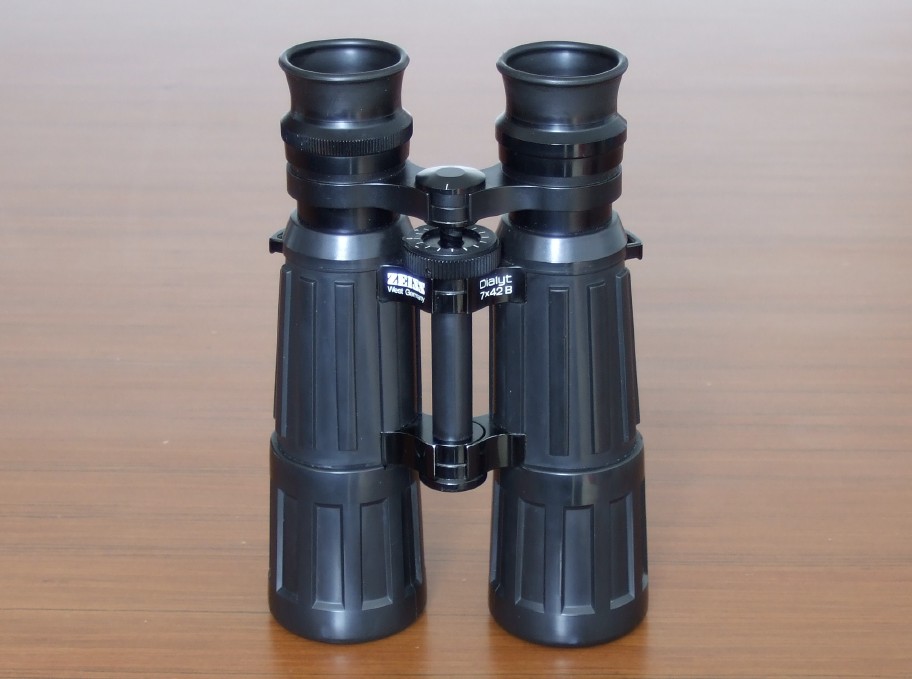

Fig. 2: The Zeiss 7x42 B/GA Dialyt, made in 1988
This binocular was introduced by Zeiss in 1981 and quickly gained the reputation of being an outstanding performer, even when compared to other members of the Zeiss line. Its body appears tall for a 42mm binocular, a result of Abbe-Koenig type prisms which build long, but, in contrast to the more compact Schmidt-Pechan type, fold the light-cone by total internal reflection only. Consequently, they do not require any mirror-coating at which light would get lost, making an exceptionally bright image when compared to other roof-prism designs of that time. Since 1988, the phase-correction coating (also called P-coating) was implemented, which shifted the level of contrast to that of the better Porro prism binoculars. The present sample was made around that time and already contains the P-coating. Later versions were called 'ClassiC', and finally discontinued in 2004, when the Victory FL emerged. Nowadays, the Zeiss 7x42 Dialyt is found second hand for typically 600-700 Euro (in its later, P-coated version).
Review: 7x42 Swarovski Habicht vs. 7x42 Zeiss B/GA Dialyt vs. 8x42 Docter B/CF
by Holger Merlitz


Fig. 1: The Swarovski 7x42 Habicht, current production
The 7x42 Habicht is made by the Austrian manufacturer Swarovski. With its magnesium body, sealed to be fully water proof and nitrogen filled, and coated with the help of latest technologies, this binocular is among the few representatives of state of the art Porro-prism designs on the market. The designer's choice to restrict its field of view to a minimum may be disputable, but it allows to keep the prisms slim and leads to an amazingly low weight of this instrument. There exists also a rubberized ('GA') version for particularly rugged applications. This binocular was already tested in an earlier review, and costs about 600 Euro (GA version: 700 Euro).

Fig. 3: The Docter 8x42 B/CF, current production
The B/CF series, which also contains the 10x42 B/CF, was designed around 2000 by Docter in Eisfeld. Although it is sometimes claimed to be a successor of the famous Zeiss Jena Notarem, the similarities are few and I suspect that these binoculars were actually designed from scratch. The 42mm objective is a quadruplet, i.e. made of no less than four lens elements. Further features include spectacle-friendly oculars (B), twist-up eye-cups and a central focuser (CF). This binocular is nitrogen filled, fully sealed with internal focuser, and specified to be submersible up to 3m. Its extra-rugged rubber armor makes this binocular feel like a Mil. spec. device and no doubt it is made for applications under most demanding conditions. The price tag in Europe is between 600 and 700 Euro, but I have occasionally seen considerably lower off-sale prices in US.

Fig. 4: The Swarovski Habicht, Zeiss Dialyt and Docter B/CF
The following table summarizes some of the specifications of the contenders.
Real angle Apparent angle Eye relief Exit pupil Weight
of view (deg) of view (deg) (mm) diam. (mm) (Gram)
Swarovski 7x42 Habicht 6.4 45 14 6.0 620
Zeiss 7x42 Dialyt 8.6 60 18 6.0 800
Docter 8x42 B/CF 7.5 60 16 5.3
Optical performance
Angle of view: Both the Docter and Zeiss can be regarded as moderate wide-angle binoculars. A 60 degs. apparent field of view is not frequently found with 8x42 binoculars, and very rare with 7x42. Since today's trend goes towards low weight and compact binoculars, optical designers have become reluctant to offer wide fields of view which require larger prisms and expensive oculars with additional lens elements (but: Check the No. 9 of the collected wisdoms). The Habicht is an example for this trend: With only 45 degs. field, it merely offers a tunnel-view, but the binocular, despite of being a Porro-design, is significantly less heavy than its two competitors.
Image sharpness: As usual with binoculars of decent quality, sharpness is a non-issue within the central part of the image, since any of them is doing perfectly well here. Towards the edge, the Dialyt, with its large true field of view, has to carry a heavy burden, but this problem has been masterly solved by the optical designer: A star image, being point-like close to the center, develops some blur when shifted to the edge, but very gradually. In fact, it is quite difficult to fix a point from which onwards the star might be called 'blurred', it happens somewhere between 60% and 70% towards the edge. This implies that during daylight observations, the aberrations remain almost unnoticed except near the edge. The Docter is able to keep any image blur outside the 75% radius, beyond that, the star image is degrading more rapidly. This is an excellent performance for a wide angle 8x42 binocular, and for sure the investment into sophisticated quadruplet objectives is paying off here. The Swarovski provides an even better edge sharpness: Up to about 80% the stars remain point-like and at the edge they are still of tolerable shape. Of course, one has to recall that the Swarovski's field is so narrow that critical areas of the field were excluded from the very beginning, and it is likely that the optical design did not require anything more than ordinary 3-lens-element reverse Kellner oculars. The Docter, if cut down to 45 degs., were sharp to the edge, and the Zeiss almost so.
Image color: All three binoculars deliver a neutral image color. There are some minor differences: Both Zeiss and Docter produce a somewhat warmer tone, a little towards yellow, while the Habicht appears to be absolutely white, if not a tad bluish. None of them has got any objectionable color tint, however. The Zeiss does in fact produce an excellent bright image, but the more recently built competitors are able to deliver the same level of brightness and contrast.
Rectilinear distortion: All three binoculars show a moderate amount of pincushion distortion as it is commonly employed to compensate for the 'rolling ball' effect and to provide a smooth panning of the image.
Stray light: Under difficult viewing conditions, especially at twilight, light from sources outside the field can enter the objective lenses through a large angle to illuminate the tube walls and is, partially, scattered into the optical path. The prevention of such a diffuse stray light is a particular strong side of the Dialyt, achieved with an array of perfectly placed internal baffles and prism shields. The Habicht is doing almost equally well, especially if stray light from above is involved, usually the most notorious cause of trouble, when the sky-glow interferes with observations of shadowed areas on the ground. The Habicht is, however, a little sensitive to stray light from the side, which can be easily confirmed when observing areas of the night-sky around the moon. The Docter can develop a faint diffuse ring in the outer areas of the field, particularly after sunset when the eye-pupils begin to expand and to touch the edge of the exit pupil. However, the level of stray light remains very low and does not compromise the contrast within the central area of the image.
Ghost images: If, at night, a bright object (street lantern, moon) is positioned into the field, reflections on the air-to-glass surfaces take place, which can lead to multiple 'ghost' images of the light source. At this point, the age of the Zeiss Dialyt (made in 1988) comes into play: Once a sufficiently bright lantern is observed, a colorful array of faint ghost images is produced. The number of these ghosts reflects the sophisticated and complex ocular construction of the Dialyt. A similar effect shows up through the Docter, but it requires a somewhat brighter light source to achieve the same ghosting experience. This is a nice demonstration of the advance in coating techniques over the last 10+ years: While assuming that the Dialyt's T* coating was state of the art in 1988, we may claim the upper middle class of the early 2000s to be coated even better. This is all the more true for the Swarovski, delivering a perfect image of the same lantern which causes trouble with the Docter and, more so, with the Dialyt. I also assume that later samples of the Dialyt are likely to offer further improved coatings and therefore perform better in such a test. To be fair, it should be pointed out that the level of ghosting displayed by the Dialyt is low - in real life applications, these effects are not likely to create any objectionable degradation of contrast.
Low light performance: The Zeiss and the Swarovski are performing equally well here. With 6mm exit pupils, these are specialists for low light, and they are also well protected against stray light, delivering maximum contrast under most difficult light conditions. The Docter, with 5.25mm exit pupil, is naturally a little behind in this discipline, but nevertheless an excellent performer for such a type of binocular. The combination of excellent coatings, good stray light protection, and its wide and bright image allow the Docter to perform well even under deep twilight conditions.
Mechanical construction
At this price, the mechanical construction of a binocular is naturally on a very high quality level. The Zeiss and Docter both feel like bomb-proof machines, and there is no doubt that any of them would take decades of intense usage without producing any flaws. The Habicht feels very light and almost fragile, but this is a deception since it applies a magnesium-alloy for its body, which is of low weight but high strength. The Habicht is nitrogen filled and submersible, rare enough for a Porro binocular with central focuser. The Zeiss is splash-waterproof (or rainproof), but not submersible. As a compensation, it is protected with a tough rubber armor, which is missing with the Habicht (but available for the 'GA' version). The Docter has got both, water resistance up to 3m, and a thick neoprene armor which should effectively absorb considerable mechanical impacts. This binocular has also got a very comfortable and precise focusing mechanism, and offers twist-up eye-cups, although I am not too happy with them: When fully extended, I cannot see the entire field. If pushed half way down, however, they won't stay there for long so that I have to frequently adjust the eye cups again, which can be annoying at times. Fortunately, the rubber cups of the Dialyt extend just far enough for a convenient observation of the entire field. With the Habicht this aspect is not so critical, since its narrow field can be seen over anyway, and, if the eye-cups are folded, even when using eye-glasses, despite of its short eye-relief of 14mm. The Docter's (16mm) and Dialyt's (18mm) eye-reliefs are also long enough for use with spectacles.
Summary
The following table is supposed to summarize the above observations. The best performing binocular gets three points, the following contenders two and one, respectively. In case several binoculars are ranking equally, their scores are averaged.
Angle of Image Stray Ghost Low Image Mechanical Final
field sharpness light image light color construction score
Swarowski 7x42 Habicht 1 3 2 3 2.5 2 1.5 15
Zeiss 7x42 Dialyt 2.5 1 3 1 2.5 2 1.5 13.5
Docter 8x42 B/CF 2.5 2 1 2 1 2 3 13.5
The 'final score' is the sum of the individual scores and is intended to serve as an orientation only.
The above 'warning' not to take the scores too seriously is particularly true for this review. I would go so far to claim the optical performance of all three contenders being equally excellent, and most of the apparent differences mentioned above are of little, if any, relevance for practical applications. These are good binoculars, and the task to distinguish their stray light, ghost images and edge sharpness is running the risk of becoming an exercise in hair-splitting rather than being a field test of practical relevance (check also the No. 6 of the collected wisdoms). As an example, imagine the lens-coating being further improved, then it would just require a lantern of higher intensity to produce the ghost images. If further improved, we had to come closer to generate the same effect. But does it matter for those applications in which we are not interested in studying the internals of a light bulb during nighttime? Most likely, not.
The good thing is: Instead of being forced to study the optical merits of these binoculars, the potential buyer may peacefully focus on practical questions: Am I willing to carry around 800g? If not, the Habicht is the right choice, and in fact it could turn very difficult to find a night glass of less than 620g. Am I willing to live with a tiny field of view of 45 degs.? If not, the Habicht is out. Do I need it for marine use? If yes, the Zeiss is out. Do I need particularly high low light performance? If yes, the Docter is out. Further criteria might include the type of eye cups, the focuser, usability with eye-glasses, the manufacturer's warranties or simply the look and feel of the instrument. My personal impression? I respect the level of perfection realized with the Habicht, and I admire the high level of engineering put into the Docter, and, somehow, I love the Dialyt - don't ask why! If there existed a discipline called 'ease of view': The Zeiss would score high there.
A question stated above was addressing the suitability of 7x42 binoculars as substitute for the all-around 8x42 size. I don't see any obstacles, but I would choose the 7-power if and only if it delivered a wider field than the 8x binocular of interest. Since I can hold 8x binoculars steadily enough, image stability won't be a reason for me to sacrifice magnification. One has to consider that the 7x binocular will usually show more aberrations, at the same apparent angle, than its 8x counterpart, a result of its wider (true) angle of view. On the positive side, its superior low-light performance may turn out to be an important feature under certain conditions.
This review indicates that recently made binoculars continue to benefit from technical improvements. As a result, today's second line of binoculars, represented by the Docter B/CF and the Swarowski Habicht, is fully competitive with the high-end of the late 1980s, as represented by the Zeiss 7x42 Dialyt, and in some aspects, like lens coating or water resistance, they are even a bit ahead. In turn, this Zeiss is by far superior to another Zeiss 10x40 Dialyt of the 1970s, which again was a high performer of its time, but only singly coated and without the P-layer.
Links
A review of the Zeiss 7x42 Dialyt, by Kenny Jones
Disclaimer
The information given in this report reflects the personal impression and opinion of the author only. I cannot guarantee for the accuracy of any given specification. I have neither been payed nor have I been supported in any other way to write this review. I thank Mr. Wang who left his Swarowski Habicht with me for testing.
Holger Merlitz: merlitz@gmx.de |
    
Ld
Username: Ld
Registered: 01-2007
| | Posted on Wednesday, October 29, 2008 - 11:22 am: | |
松江名勝何其多,千島阿城,嫁之島。
城山的花。春天的紅葉,愛岩的月,津田的雪。
請看使出雲聞名的宍道湖,浮出的嫁島和浪花。
伴着晴朗的藍天,觀賞松江的湖水玉般的大橋。 |
|


























































